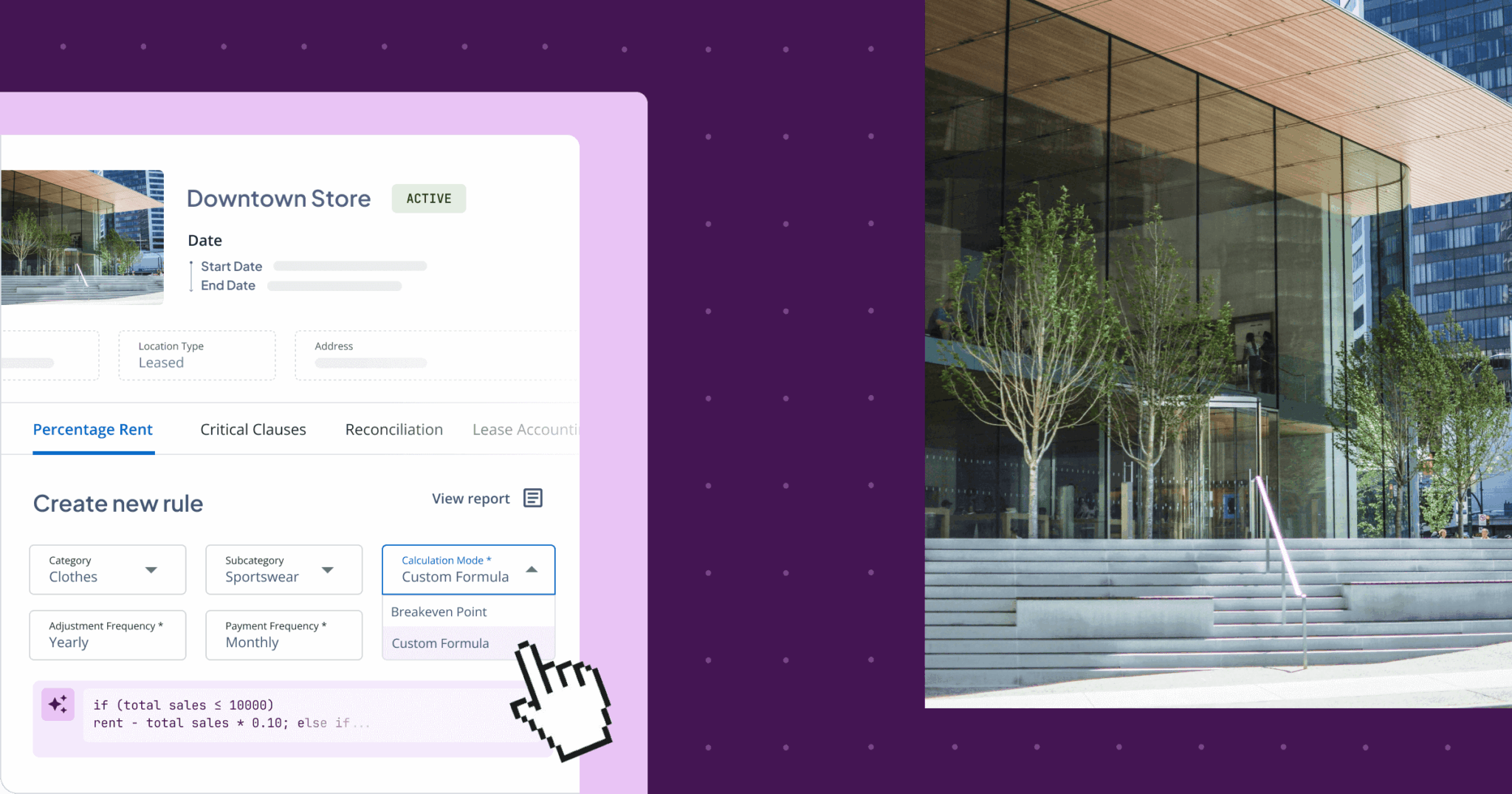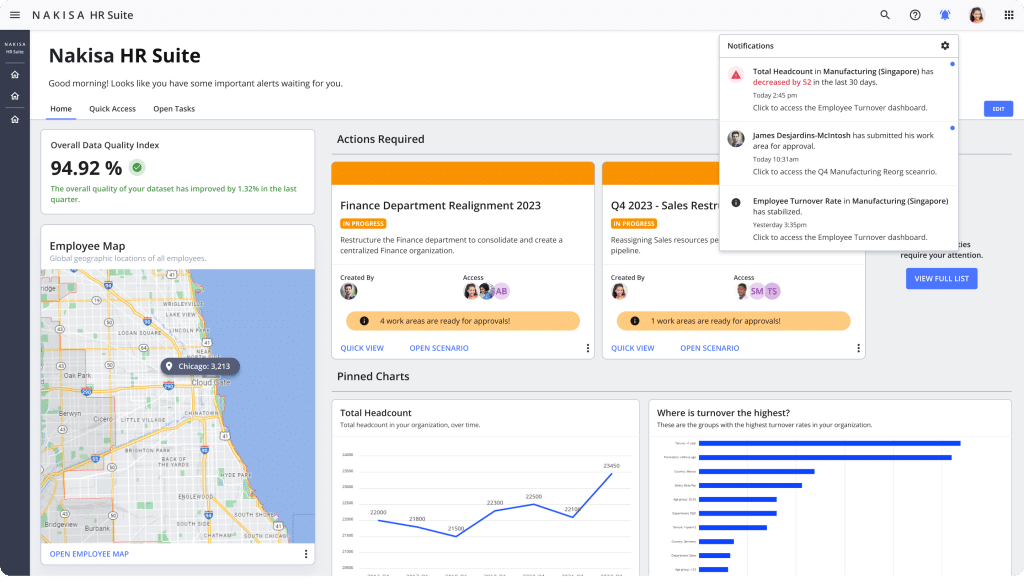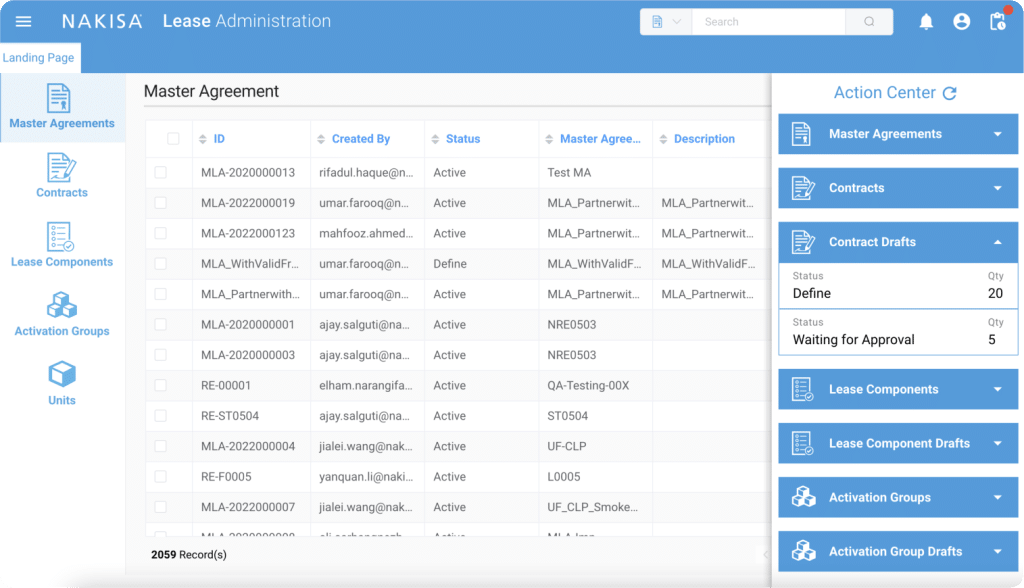Key business priorities for retail growth and efficiency
For global retailers, managing extensive asset portfolios (including real estate, equipment and machinery, fleet and transportation) across multiple locations while staying competitive is a complex endeavor that requires a careful balance between agility, operational efficiency, and cost control. To navigate these challenges effectively, retailers must focus on key business priorities that will enable them to streamline operations, enhance decision-making, and drive sustainable growth. The following priorities are essential for retailers looking to thrive in today’s fast-paced market.
Enhancing operational efficiency through automation and simplification: Retailers juggle numerous tasks, from site selection to lease administration, complex rent calculation and reconciliation, lease accounting and compliance, maintenance management, and vendor coordination. Automating these processes minimizes errors, reduces administrative overhead, and frees up teams to focus on strategic initiatives that drive growth.
Optimizing portfolio performance with data-driven insights: Retailers need real-time visibility into asset performance, space utilization, and profitability across locations. By leveraging centralized data and analytics, they can quickly identify underperforming stores, optimize space usage, and uncover opportunities for expansion or cost reduction.
Adapting to market trends with agility and flexibility: To stay competitive, retailers must anticipate shifts in consumer behavior, economic conditions, and technological advancements. A data-driven approach provides insights into market conditions, location performance, and emerging trends, enabling quick strategy adjustments. Whether expanding to new locations, optimizing capital projects, renegotiating lease terms, or reallocating resources, this approach supports timely decisions that drive growth and responsiveness.
Ensuring compliance and mitigating risks: Retailers operate in a complex regulatory environment with lease accounting standards (IFRS 16, ASC 842, local GAAP), tax laws, and data privacy regulations. Non-compliance can lead to costly fines and operational disruptions. A compliant portfolio management approach ensures adherence to these standards while maintaining financial transparency.
Advancing sustainability initiatives: Retailers are increasingly focused on reducing their carbon footprint, improving energy efficiency, and achieving sustainability goals. Tracking environmental metrics across multiple locations enables better resource management, cost savings, and a stronger brand reputation.
Breaking down silos to improve cross-departmental collaboration: Real estate, finance, operations, and facility management teams must work in sync to ensure smooth business operations. An integrated platform with streamlined workflows fosters better communication, eliminates redundant processes, and aligns teams toward common business objectives.
An Integrated Workplace Management System (IWMS) is a centralized software platform designed to help retailers achieve these business priorities. By integrating multiple functions into a unified platform, an IWMS streamlines processes across capital planning and budgeting, site selection, contract management, payment processing, reconciliations, lease accounting, disclosures, facility management, repair and maintenance, and sustainability initiatives.
In the following sections, we’ll take a closer look at the specific challenges retailers face at each stage of the asset lifecycle management and explore how solutions like Nakisa IWMS can effectively address them.

Asset types in the retail industry
Before addressing the specific challenges retailers face, it's helpful to understand the types of assets they typically manage and their unique characteristics. These assets range from physical spaces like stores and warehouses to the equipment and infrastructure needed to keep them running smoothly. Each asset type comes with its own set of management requirements and challenges, making it essential for retailers to have a clear understanding of their portfolio.
Real estate assets
Real estate assets include retail stores (such as storefronts, shopping mall units, and standalone buildings), warehouses, distribution centers, land, and office spaces.
Each of these asset types has distinct requirements. Managing them often involves significant upfront investments for tenant improvements or buildouts, careful site selection, and negotiating and managing complex lease terms, such as rent escalations, percentage-based rent, common area maintenance (CAM) charges, and renewal or termination options. It also requires understanding zoning laws, maintaining compliance with local regulations and accounting standards, and ensuring effective facility and maintenance management to optimize the customer experience. Additionally, adherence to ESG and safety regulations is crucial. Addressing the unique needs of each asset type is essential to ensure efficient operation and compliance.
Leased equipment and machinery
In the retail industry, leasing equipment is a common practice for assets essential to daily operations. Key assets that retailers may lease include point-of-sale (POS) systems, refrigeration units, HVAC systems, networking equipment, self-checkout kiosks, and digital signage. Leasing these critical assets allows retailers to access state-of-the-art technology while minimizing capital expenditures.
Each type of equipment lease has different needs for lease management, lease accounting, and facility management, which can affect how they are tracked and maintained. Managing these leased items across multiple locations requires an integrated system to track lease agreements, manage maintenance, and optimize usage—something that an IWMS solution can streamline effectively.
Fleet and transportation assets
Fleet and transportation assets play a crucial role for efficient logistics and timely delivery in retail operations. Delivery vehicles (such as trucks and vans) are often leased to transport goods between warehouses, stores, and directly to customers. Leasing these vehicles allows retailers to manage cash flow more effectively while also providing flexibility in fleet size and maintenance needs. Retailers require to track terms, manage mileage limits, coordinate maintenance schedules, and handle end-of-term options for these assets.
Similarly, material handling equipment (such as forklifts and conveyor systems) often leased for use in warehouses and distribution centers, ensures smooth and efficient movement of goods. These assets are usually covered by specific lease terms that include maintenance requirements and service agreements, to ensure optimal performance and safety.
With this diverse range of assets, global retailers face unique challenges in efficiently managing leases, ensuring compliance, and optimizing operations. We’ll explore these challenges in detail in the next section.
Discover our buyer’s guide with RFP scorecard to select the right commercial real estate management software for the retail industry. With tailored evaluation criteria and practical insights, this guide helps you navigate the decision-making process and identify the tools best suited to your organization’s unique needs.

What unique challenges retailers face at each stage of asset and facility lifecycle management and how an IWMS addresses them
Retailers manage their assets through a series of interconnected stages in the asset lifecycle, each with its own set of unique challenges. From strategic planning and site selection to lease negotiation, operational management, and eventually lease renewal or termination, each phase demands meticulous coordination and data-driven decision-making. All those challenges are amplified by the scale and complexity of global retail portfolios.
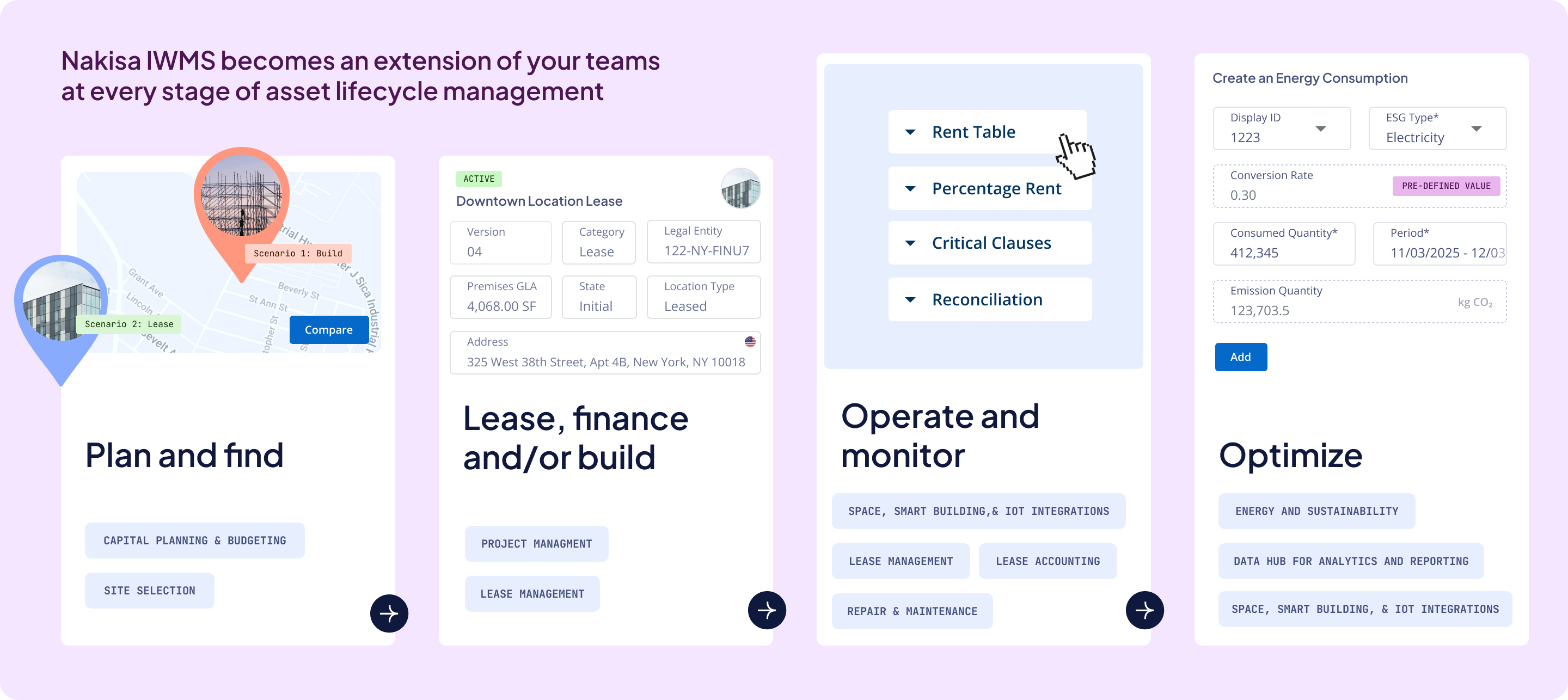
An IWMS solution provides the necessary tools to address these challenges at every stage, enabling retailers to streamline processes, enhance decision-making, and maximize asset value. Research shows that implementing an IWMS leads to measurable improvements, such as reducing capital project costs by 45%, improving facility usage efficiency by 40%, reducing enterprise asset lifecycle costs by 35%, and enhancing workspace management by 47%. In this section, we will explore each stage of the asset lifecycle for retailers, the common challenges they face, and how an IWMS solution like Nakisa can effectively address them.
Planning and finding
Let's begin with capital projects, which occur even before a real estate asset is added to the portfolio. Our focus will be on key activities such as planning, budgeting, site selection, and performance analysis, as well as the challenges each of these activities presents.
Challenge 1: Managing financial forecasting, budget allocations, and cost control for capital projects
Accurately forecasting costs and allocating resources for capital projects is not an easy task, especially for a global retailer. Aligning expenditures with business objectives demands precise cost estimation, thorough financial forecasting, and buy-in from key stakeholders—all of which can be difficult to achieve.
Improving accuracy in financial forecasting and budget allocations
Misalignment among key stakeholders and the lack of a clear, data-driven approach will lead to inefficient capital project budget allocation, ultimately affecting a retailer’s financial stability and long-term success. Before committing to a budget, it’s crucial to ensure that all stakeholders are aligned on objectives and that data and analytics are thoroughly evaluated to guide decision-making. Stakeholders should estimate key factors such as initial investment costs, operating expenses, lease-related expenses, and projected revenue to evaluate the financial impact of capital projects. By analyzing these factors, they can assess the potential return on investment (ROI) and identify risks that could affect profitability.
Inaccurate financial forecasts are common due to limited visibility into external market conditions and internal constraints. Economic downturns and supply chain disruptions must be factored into contingency plans to mitigate financial strain. The complexity of multi-market retail portfolios, each with unique cost structures and growth pressures, further complicates capital project budgeting and planning. Factors like escalations in rent, CAM (Common Area Maintenance) fees, property taxes, and unexpected fees can significantly impact store profitability. Adding to this are seasonal revenue shifts, e-commerce-driven investment adjustments, and resource bottlenecks, all of which increase the risk of financial misalignment and operational inefficiencies.
It is essential to leverage up-to-date market insights, consider organizational historical data, and use financial models to predict the long-term impact of the upcoming capital project. Accurate financial forecasting is crucial for managing leasing and construction costs across various projects and locations.
How Nakisa IWMS enhances financial forecasting and budget allocations for capital projects
In Nakisa IWMS, the Capital Projects Suite empowers retailers to analyze various financial scenarios, allocate realistic budgets, and maintain budget control. It offers advanced data visibility by integrating data from the current real estate portfolio, upcoming capital projects, external real estate insights, and market trends. This data-driven approach enables project managers and key stakeholders to make informed decisions, allocate budgets based on real-time insights, and adapt to evolving market conditions—moving beyond historical assumptions for a more accurate financial forecast.
The platform offers automatically calculated financial viability analysis for all capital projects, allowing retailers to assess potential revenue, planned investments, and key financial metrics such as Discounted Cash Flow (DCF), Net Present Value (NPV), ROI, and Break-Even Point.
Additionally, Nakisa enables global retailers to create multiple financial scenarios—ranging from optimistic to conservative—by adjusting assumptions on various factors, including sales revenue, site acquisition costs, marketing expenses, and maintenance.
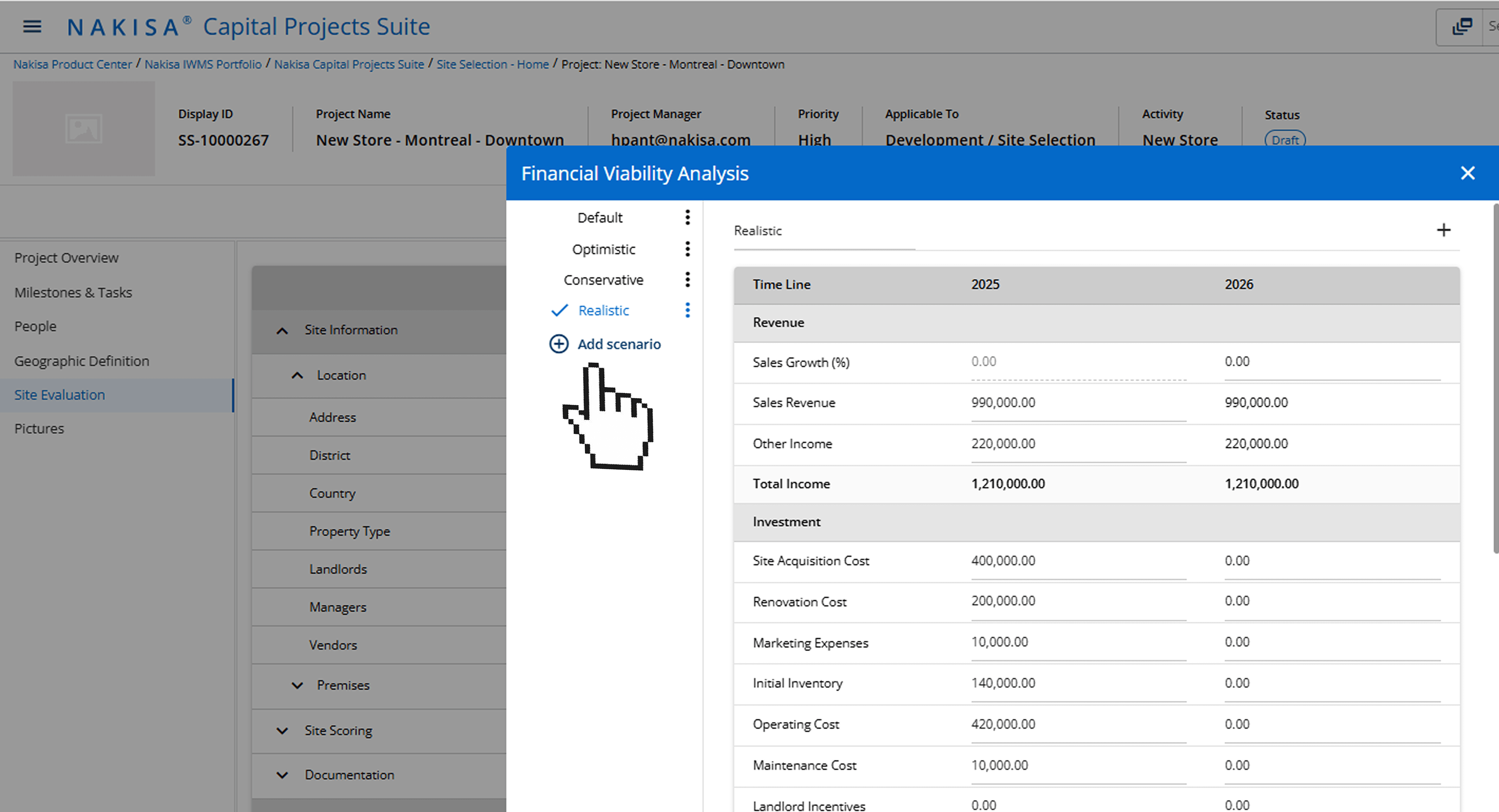
Nakisa Capital Projects enables multiple scenario creation and management for enhanced decision-making.
Financial scenario planning can be as detailed as per contract-specific terms, such as annual rent increases, seasonal performance variations, or conditional cost reductions. With just a few clicks, capital project managers can generate future payment schedules for each scenario and assess the impact of potential changes. This data-driven approach empowers retailers to make informed decisions and allocate realistic budgets for their capital projects.
Optimizing budget tracking and cost control
Once the budget is approved and allocated, managing it effectively becomes crucial. Without proper oversight, costs can quickly spiral out of control, leading to unexpected expenses that strain financial resources. Inadequate tracking of expenditures and failure to adjust forecasts based on real-time data can result in misallocation of funds, delays in project timelines, and diminished returns on investment. Additionally, the absence of stringent cost control measures during project execution increases the likelihood of overspending, missed opportunities for cost savings, and a failure to meet profitability goals. To mitigate these risks, retailers should implement analytics tools to track spending and forecast costs accurately. Real-time monitoring, coupled with hard stops and automatic notifications when overruns occur, can help maintain financial discipline and ensure timely intervention. By doing so, retailers can closely monitor budgets and make necessary adjustments to stay aligned with business objectives.
How Nakisa IWMS optimizes budget management and cost control
With configurable, role-based workflows and a multi-level approval system, Nakisa ensures alignment across key stakeholders, from C-level executives to Finance and Real Estate teams. Once approved, budgets can be distributed across multiple capital projects or expense categories for enhanced visibility and control. What’s more, a single capital project can encompass multiple budgets, providing greater flexibility in financial planning and management.
Nakisa IWMS helps retailers manage costs by offering tools for accurate budget tracking in multiple currencies. Capital project managers can monitor budgeted versus actual expenses in real-time and track remaining budget availability. Built-in hard stops automatically flag and halt transactions exceeding budget limits, while automated notifications and email reminders ensure prompt action from the appropriate team members.
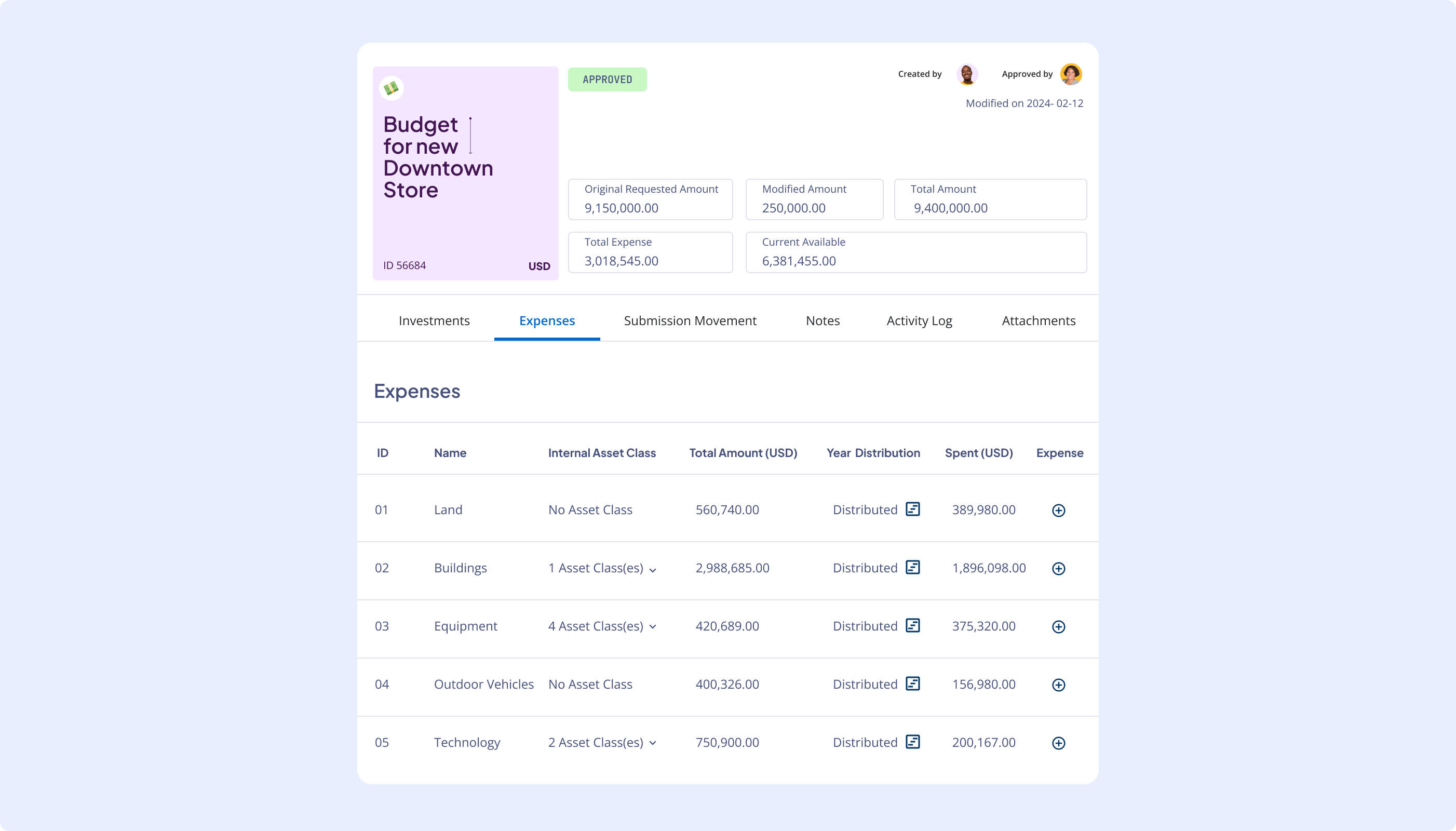
You can easily manage capital project budgets and track the associated expenses in Nakisa Capital Projects (part of Nakisa IWMS)
With advanced invoice management, Nakisa IWMS allows external partners to upload invoices through the Partner Portal. This centralized approach enables retailers to track budgeted, contractual, and invoiced expenses in one place, providing enhanced transparency and accuracy.
With real-time expense monitoring and AI-driven Assistant, capital project managers gain actionable insights into expenditure patterns, enhancing financial discipline and improving future estimates.
Moreover, Nakisa offers budget management and cost control not only for capital projects but also for leases and facilities. The platform tracks construction costs, capital project expenses, lease costs (including rent payments, taxes, insurance, and utilities), and facility maintenance costs (such as scheduled work orders or repairs). All this data and functionality is seamlessly organized for each team and role, ensuring that users can leverage a centralized source of truth in a straightforward and user-friendly manner, without feeling overwhelmed.
Challenge 2: Finding the best location for retail operations
For global retailers, optimizing site locations is critical, especially for stores, pick-up points, distribution centers, and warehouses. Rapid growth requires balancing customer demand with market opportunities, along with the operational realities of expansion across international markets.
To find an optimal site, retailers need to evaluate multiple factors, such as demographic trends, competitive landscapes, and logistical considerations, all while ensuring that new locations contribute to long-term profitability.
Aligning site selections with long-term retail growth strategies requires careful evaluation of location potential and portfolio optimization on a global scale. Retailers must ensure that each site, whether new, renewed, or terminated, supports overall business goals such as expanding market presence or boosting omnichannel operations across different regions. However, prioritizing sites based on projected ROI, market share, and customer proximity remains challenging due to the complexity of balancing numerous variables such as market conditions, competition, and location specifics, and logistical feasibility.
Fragmented communication and siloed systems further complicate the process, as executives often lack a comprehensive, real-time view of the portfolio, relying on fragmented insights from multiple teams. Property and capital project managers often use disconnected tools and manual data management. Combined with outdated or inconsistent data sources, it hinders the evaluation of factors like foot traffic, consumer demographics, and local trends, leading to poor site decisions and missed opportunities.
Additionally, failing to track evolving market conditions, including competitor store openings or closures and shifts in consumer demand, can result in poor site decisions, missed revenue opportunities, or underperforming retail locations.
How Nakisa IWMS optimizes site selection for global retailers
The Nakisa Site Selection solution, part of the Nakisa Capital Project Suite, empowers global retailers with purpose-built features to find an optimal location, aligned with the business strategy. Here’s what it offers:
- Centralized site repository: A comprehensive list of all potential and existing sites, including site details, photos, documentation, configurable KPI metrics, and financial forecasts. Capital project managers can visualize sites on a map with Geographic Information Systems (GIS) integration and analyze surrounding areas for valuable insights to drive higher traffic, boost sales, and support strategic expansion or consolidation. Robust filter capabilities and dynamic dashboards make it easy to slice and dice through data, enabling efficient site searches based on various parameters.
- Reports and advanced analytics: Nakisa IWMS provides advanced market analytics and geographic data to identify prime locations aligned with target audience profiles. It integrates external data sources, such as real estate market data, foot traffic, and demographic insights, via powerful APIs. This ensures accurate, up-to-date insights into demographic trends, consumer behavior, local trends, and competitive landscapes, eliminating reliance on outdated data. Retailers can confidently evaluate potential sites for expansion, relocation, or downsizing.
- Site alignment with strategic goals: Capital project managers can configure location scorecards with any KPI metrics critical to their business, such as customer demographic match, population density, site location quality, street visibility, or any other criteria. Each metric can be assigned a custom weight, and locations can be scored accordingly. When choosing the optimal site for a capital project, managers can compare up to ten sites side by side and shortlist the best options for this specific project. They can assess the total score per each location and drill down into individual metrics as needed. Besides this functionality, the site comparison table provides detailed site information, including dynamic area size conversion. It also has the financial viability analysis, allowing retailers to assess potential revenue, planned investments, and key financial metrics such as Discounted Cash Flow (DCF), Net Present Value (NPV), ROI, and Break-Even Point.
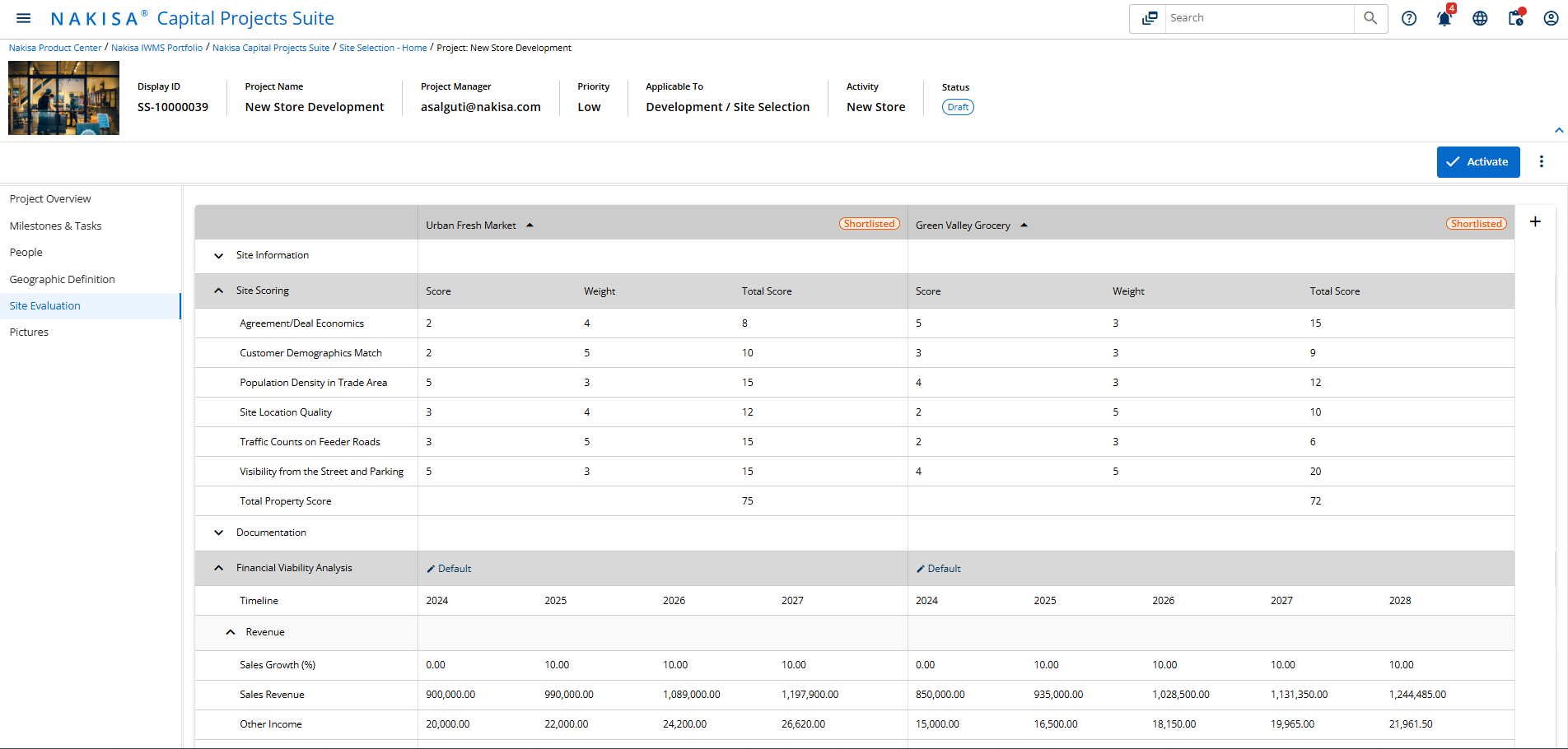
During site selection, compare up to 10 locations side-by-side, evaluating site scores and financial analysis. Shortlist locations and make informed portfolio decisions to drive higher ROI with Nakisa IWMS
Challenge 3: Effective capital project management for global retailers
Project management is critical for global retailers when financing, building, or renovating their retail spaces. Above, we covered financial forecasting, cost monitoring, and location selection, all of which can also be considered parts of capital project management.
In this section, we’ll focus specifically on project management challenges, including timeline and milestone tracking, project prioritization, internal team coordination, third-party collaboration, and regulatory compliance. Effectively managing these processes is crucial to delivering projects on time while minimizing risks to profitability and operational efficiency.
Managing project priorities, timelines, and milestones
An important aspect of capital project management is determining which activities to prioritize based on ROI and strategic alignment. The need to balance aggressive growth strategies with tight budgets heightens the difficulty of accurately prioritizing and allocating resources. This lack of alignment can delay projects, frustrate stakeholders, and result in the misallocation of resources, ultimately diminishing the success of capital planning.
Once priorities are set, global retailers must manage multiple projects, each with a series of milestones, tasks, and approvals that must stay on schedule. Retailers often face tight project timelines, especially when projects must be completed before key retail seasons or promotional periods. Coordinating schedules across internal teams, external vendors, and contractors adds further complexity.
Delays often stem from manual processes, vendor performance issues, cost overruns, or missed deadlines, leading to inefficiencies and stakeholder dissatisfaction. Without a clear structure and regular progress checks, managing multiple projects can overwhelm capital project managers, driving up costs and slowing execution.
To ensure on-time project delivery, retailers must streamline task tracking, monitor progress in real-time, and enhance team coordination—minimizing bottlenecks and maximizing efficiency.
How Nakisa IWMS streamlines priority, timeline, and milestone management
The core value proposition of Nakisa Capital Projects is that it offers purpose-built functionality for capital and real estate projects, tailored to CRE-specific needs. Capital project managers can define the project’s main activity, whether opening a new location, expanding, relocating, downsizing, or closing. They can set project scopes (premises-only or full site development), assign priority levels, and control privacy settings to keep sensitive projects secure.
Nakisa Capital Projects supports project oversight by offering detailed tracking tools for monitoring project milestones, site progress, and approvals in real-time. Project managers can create projects, attach tasks and milestones to them, all while prioritizing the most critical activities. They can also assign internal and external team members, establish clear deadlines, and use Gantt charts with automated reminders to keep tasks on track, preventing delays and maintaining project flow across global operations.
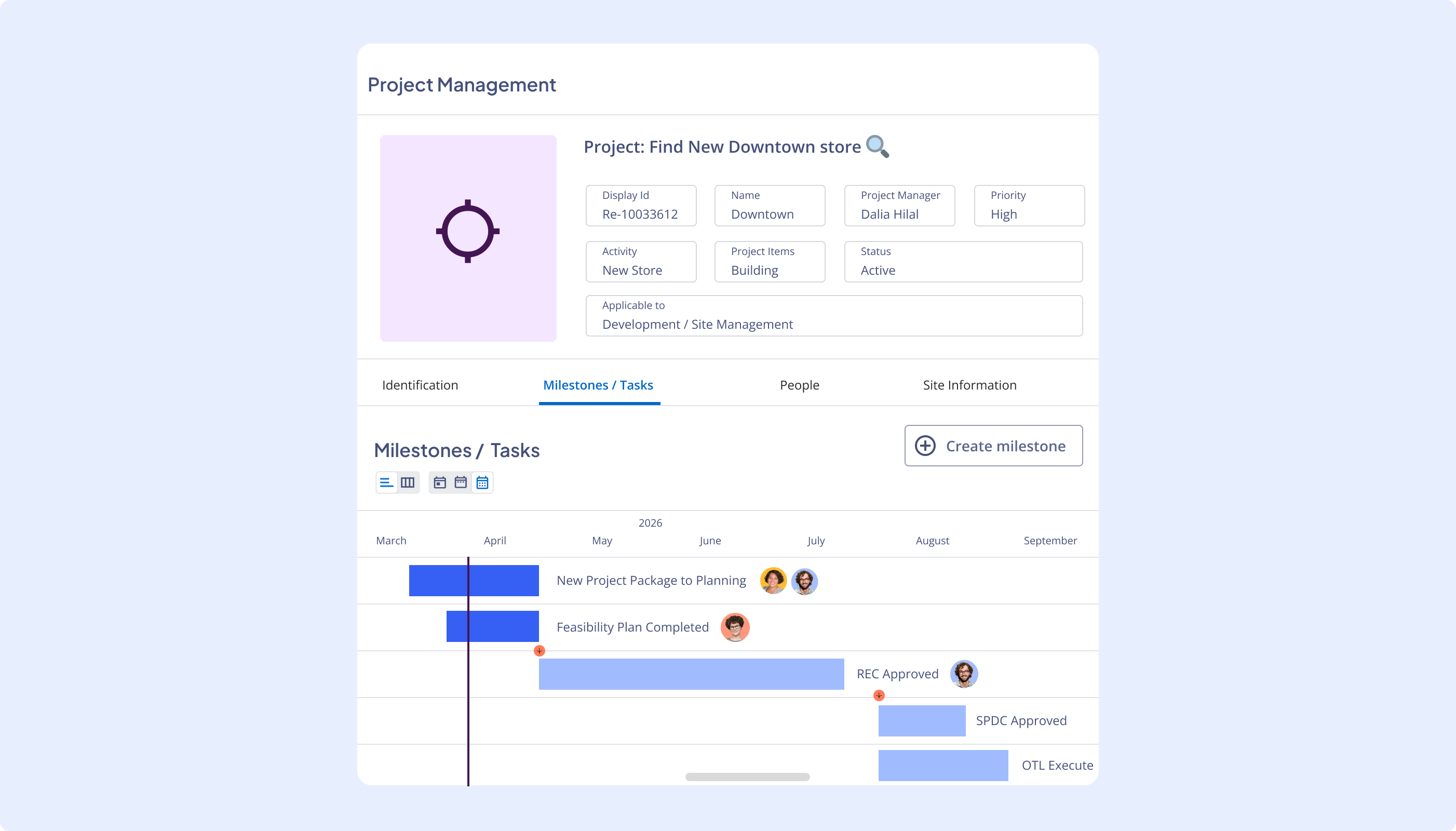
Create and prioritize tasks, assign people, and stay on top of the deadlines with Nakisa Capital Projects
The platform also offers tailored templates for various project types—such as site openings, expansions, relocations, and closures—adaptable to different countries and regions, and easily configurable. Retailers can also create their templates, adapted to their specific business needs. These templates ensure tasks are organized, progress is tracked, and adjustments are made as necessary, improving project efficiency and reducing the likelihood of delays or budget overruns. Reusable project and milestone templates standardize processes and ensure key project steps are not overlooked while offering flexibility to adapt to changing project needs.
Enhancing internal collaboration
Managing global projects requires seamless coordination between the capital project team and various internal departments, including legal, finance, operations, and project management. Each team brings its own priorities, workflows, and deadlines, which can sometimes conflict, leading to bottlenecks that delay progress.
One of the biggest challenges is ensuring alignment across these teams while maintaining clear communication. Without a centralized system to track project status, responsibilities, and dependencies, teams may struggle with miscommunication, duplicated efforts, or overlooked tasks. This lack of visibility can result in missed deadlines, budget overruns, and operational inefficiencies.
Additionally, as projects scale across multiple regions, time zone differences, language barriers, and varying regulatory requirements add further complexity. Ensuring that all internal stakeholders have real-time access to project updates, approvals, and financial data is crucial for keeping projects on track.
How Nakisa IWMS facilitates cross-departmental collaboration
Effective internal collaboration requires well-defined roles, clear task ownership, and structured workflows that enable teams to work efficiently. Nakisa IWMS serves as a single source of truth, allowing any team member to check assigned tasks, deadlines, and responsibilities in real time. This eliminates confusion, enhances accountability, and streamlines project execution. As mentioned earlier, project and milestone templates further simplify task management by providing standardized workflows.
To keep teams aligned, Nakisa IWMS includes reminders, in-app notifications, and an action center that consolidates all relevant action items per user. Teams can easily track mentions, assigned tasks, and pending approvals, ensuring nothing falls through the cracks.
The platform also offers flexible access controls, allowing project owners to add participants and define their level of involvement. Capital projects can be set as private (visible only to participants) or public (accessible to all users), ensuring the right people have access to the right information without overwhelming others with unnecessary details.
Additionally, Nakisa IWMS enhances stakeholder coordination. Teams such as legal, finance, and project management can view only the information relevant to them, reducing miscommunication and improving efficiency. Proposals and comments further enhance collaboration by tracking stakeholder feedback, ensuring full visibility across teams.
Enhancing external collaboration: contractors, advisors, landlords, suppliers, and more
Global retailers must also handle relationships with multiple vendors and suppliers across different countries. Managing these relationships, ensuring they meet performance expectations, and staying on top of contracts can be extremely complex—particularly when dealing with multiple sites and projects simultaneously. Delays, quality issues, or changes in cost can disrupt timelines and escalate costs, causing frustration and inefficiencies across the board. The challenge is further complicated by the need to develop and maintain large-scale supplier relationships internationally while navigating global supply chain disruptions.
How Nakisa IWMS facilitates external collaboration with third parties
Nakisa Capital Projects, along with other product suites in Nakisa IWMS, provides a powerful Partner Portal designed for seamless third-party collaboration. This enables real estate professionals to efficiently manage vendors, landlords, suppliers, and contractors within a structured and centralized system.
The Partner Portal serves as a comprehensive database, storing essential details such as vendor names, locations, project-specific commitments, and historical performance metrics. It ensures easy tracking of third-party engagements, payments, and contractual obligations, helping organizations optimize vendor selection and maintain strong business relationships.
To enhance efficiency, Nakisa IWMS also includes standardized communication templates, reducing manual effort and ensuring consistency in vendor interactions. The dedicated Partner Portal allows external collaborators to directly upload invoices, credit notes, and supporting documents into the system, enabling real-time tracking, automated reconciliation, and improved financial accuracy.
By centralizing all third-party collaboration activities, Nakisa IWMS minimizes communication gaps, enhances transparency, and streamlines administrative processes, ultimately driving more efficient and cost-effective capital project execution.
Navigating regulatory compliance and risk management across jurisdictions
Managing compliance with regulations across multiple jurisdictions is a critical part of global capital project management. Retailers face the risk of non-compliance, which can result in fines and delays. They must also navigate retail-specific regulations such as those related to consumer safety, product labeling, accessibility standards (e.g., ADA compliance), and data privacy (e.g., PCI DSS compliance for payment systems). Additionally, unforeseen risks such as supply chain disruptions, economic shifts, or natural disasters complicate project planning, leading to costly delays or cancellations. Insufficient risk management and lack of contingency planning exacerbate these challenges, leaving projects vulnerable to changing conditions.
The complexity is amplified by the need to navigate sustainability initiatives and unclear government directives related to environmental standards across different markets.
How Nakisa IWMS ensures compliance with global regulations
Nakisa IWMS provides centralized compliance tracking, enabling retailers to stay on top of regulatory requirements throughout the project lifecycle. Here’s how Nakisa helps mitigate these challenges:
- Centralized project data and regulatory tracking: Nakisa centralizes all project data, enabling managers to track project progress, regulatory requirements, and compliance status in one place. The platform provides real-time visibility into every aspect of the project, ensuring that stakeholders are aligned and any potential issues are addressed before they become major roadblocks. For each project, capital project managers can add risk level and environmental effect estimates, allowing for better-informed decision-making and proactive management of potential challenges. This ensures that all necessary approvals and certifications are readily available when needed, reducing compliance risks and improving audit readiness.
- Proposal comments: To enhance documentation and accountability, Nakisa IWMS streamlines compliance-related communication with its proposal comments feature, allowing capital project managers to track discussions, approvals, and regulatory concerns. This structured approach minimizes miscommunication and creates a clear audit trail, making it easier to demonstrate compliance during inspections or audits.
- Tracking compliance metrics: With Nakisa Capital Projects, retailers can define custom compliance metrics using scorecards for each site, ensuring every location is evaluated against relevant legal and operational requirements.
- Energy management: Nakisa also supports energy management tracking to help retailers align with ESG (Environmental, Social, and Governance) standards. By monitoring energy consumption and sustainability initiatives, retailers can proactively manage environmental compliance, reduce their carbon footprint, and adhere to green building regulations.
- Risk management and contingency planning: The platform’s real-time tracking and forecasting capabilities enable capital project managers to quickly identify emerging risks and adjust plans accordingly. With robust scenario modeling and contingency planning features, users can simulate various scenarios to determine their impact and implement corrective actions early on.
- Streamlined facility management and building code compliance: Nakisa Facility Management includes asset status tracking, ensuring real estate assets comply with building codes and safety regulations. This feature helps retailers manage maintenance schedules, structural inspections, and renovations, preventing compliance issues and maintaining operational integrity.
- Zoning and construction considerations: Some projects require adherence to zoning regulations, and Nakisa helps ensure these are properly managed. With centralized documentation, detailed project descriptions, and configurable KPI metrics, the platform ensures that all team members are aware of the requirements and that all projects align with local zoning laws. Additionally, the system monitors timelines for approvals or necessary repairs, to keep projects on track without delays.
Challenge 4: Overcoming technology integration challenges in retail asset management
Integrating advanced technology to support site selection is essential for modern retailers but often proves to be challenging. Retailers often rely on inefficient processes (such as manual data aggregation and analysis) or fragmented CRE systems and struggle to gain a holistic view of potential sites and projects. This lack of streamlined data-driven workflows results in slower decision-making and more costly errors.
Without seamless integration between their real estate systems, real estate professionals risk making investment decisions in isolation, for instance, planning a new store while overlooking insights from their existing real estate portfolio. A lack of visibility into current leases with similar characteristics can lead to suboptimal site selection and missed opportunities for cost savings.
Additionally, all capital project costs, including construction, lease initiation, and associated expenses—must flow through finance and ERP systems. However, manual data entry across multiple systems (ERP, finance, real estate, and facility management) slows decision-making and hinders agility in responding to market shifts, reducing overall capital planning effectiveness.
Retailers also face the challenge of integrating capital planning systems with retail-specific technologies such as point-of-sale (POS) systems, inventory management software, CRM tools, and e-commerce platforms. This integration is crucial for making informed decisions based on real-time operational data.
Traditional methods, such as manual forecasting and reliance on spreadsheets, often lack the accuracy, depth, and flexibility required to overcome these challenges. Inefficient processes can lead to forecast errors, misallocated resources, and delayed responses to changing market conditions. To optimize investments and ensure efficient capital project execution, retailers need streamlined processes and integrated solutions like Nakisa IWMS.
What integrations Nakisa IWMS offers and their benefits
Nakisa IWMS’s cross-product integration, native bidirectional integration with major ERP systems like SAP, Oracle, and Workday, and robust APIs ensure seamless data flow, effectively addressing the complex technological ecosystems of global retail enterprises. Let’s explore how each type of integration benefits global retailers:
- Cross-product Nakisa IWMS integration: Nakisa IWMS enables various teams to leverage a single, up-to-date data repository, ensuring that information is seamlessly shared between capital project, real estate, and facility teams. Each team has its own user interface, but they all have access to the same core data. For example, capital project managers can analyze the current CRE portfolio before initiating a new project, allowing them to evaluate the new project in context and make strategic growth decisions. Once a capital project is executed, it automatically becomes a premise in the CRE portfolio, where it can be managed further, including lease management and lease accounting. Similarly, the premise can be added to the facility management system to ensure proper maintenance and property performance. Nakisa also collects comprehensive vendor, landlord, and contractor information across all its products, providing valuable insights for improved vendor management and future project planning.
- Finance systems and ERP integration (SAP ECC, SAP S4/HANA, Oracle, Workday): Nakisa offers a powerful accounting engine that can be easily integrated with various finance platforms, including BlackLine. This ensures smooth data flow between real estate and accounting teams. Native bidirectional integration with major ERP systems like SAP, Oracle, and Workday further enhances data flow, enabling efficiency for the accounting teams by reducing the risk of errors and performing mass postings in one click.
- API to external tools: Nakisa IWMS connects with external tools via robust APIs, allowing access to critical data such as market insights, foot traffic, and location-specific details to inform capital planning decisions. It can easily sync with external data centers specialized in CRE operations or be integrated with point-of-sale systems to analyze store performance and calculate sales-based rent, when applicable.
- Advanced analytics and Nakisa AI Assistant: With easy-to-share reports and insights, Nakisa transforms what is traditionally a manual process into a streamlined, data-driven approach. By leveraging Nakisa’s advanced analytical tools and configurable dashboards, retailers can efficiently allocate resources, prioritize projects, track targets vs. actuals, and mitigate risks associated with capital investments, optimizing them for long-term success throughout the asset lifecycle.
Nakisa AI Assistant analyzes data and can create customized dashboards per capital project managers’ requests. By inputting the requirements through our AI Assistant, capital project managers can quickly locate relevant properties and analyze data across the whole portfolio. Nakisa AI automatically processes criteria, extracting valuable insights and generating visual dashboards that provide a clear overview of key metrics. Paired with Elasticsearch and advanced filters, the AI system delivers the most relevant properties while offering real-time analytics, saving time and ensuring that your decisions are backed by data-driven insights.

Leasing, financing, and/or building
Once capital projects are prioritized and planned, retailers must navigate the complexities of leasing, financing, and/or building sites. The leasing phase involves negotiating complex terms, managing financial obligations, and staying compliant with local and international regulations. After securing the lease, the next phase focuses on financing and construction, which also requires strict coordination and oversight to meet timelines and budgets. Each step represents its own difficulties that can disrupt operations if not handled properly.
Challenge 5: Managing complex lease negotiations for global retail portfolios
Negotiating favorable lease terms and making timely decisions present significant hurdles for global retailers. The availability of prime locations is often limited, with high demand driving up prices and restricting options in desired markets. Delays in decision-making, whether due to slow internal processes or lack of coordination between CRE teams and stakeholders, can result in missed opportunities, extended store opening timelines, and settling for suboptimal locations.
While choosing between building, leasing or buying, retailers must weigh several factors, including market trends, property values, financial obligations, potential hidden costs, and the long-term impact of rent escalation clauses and renewal options. Managing these leases effectively involves tracking various financial terms, such as rent payments, taxes, insurance, maintenance fees, and utilities, which can fluctuate and affect overall profitability.
Failing to address these elements during the lease negotiation phase can lead to unexpected financial burdens down the line. Without a centralized system to monitor these terms, there is a higher risk of overlooking critical information, leading to unfavorable lease terms and potential financial strain after leases are signed. Relying on manual processes or spreadsheets increases the risk of errors and can lead to missed critical information, negatively impacting long-term profitability on a global scale.
How Nakisa IWMS simplifies lease negotiations and financial terms
Navigating lease negotiations for large, international retail portfolios requires precision, foresight, and effective management of financial complexities. Nakisa IWMS, the Capital Projects Suite empowers retailers to tackle these challenges head-on by providing a centralized, intelligent solution to manage lease negotiations, ensuring favorable terms while mitigating long-term risks. Here’s how it does it:
- Side-by-side comparison between potential sites (leased, owned, or both). Compare terms side by side, see potential revenues and planned investments, as well as automatically calculated financial KPIs to select the best location, under the best terms and conditions.
- Financial scenario modeling and forecasting capabilities: The system enables retailers to evaluate the long-term financial impact of lease terms, including rent escalation, taxes, insurance, and maintenance fees, across multiple currencies and economic environments. Contract managers can create draft leases or properties, input suggested terms and conditions, and generate future payment schedules to evaluate their financial implications. With built-in financial scenario modeling tools, retailers can simulate different outcomes, anticipate market fluctuations, and negotiate terms that optimize profitability while ensuring financial stability.
- Market data insight integration: Nakisa IWMS integrates market insights with portfolio data, allowing retailers to benchmark potential lease agreements against market trends and existing leases. This ensures that negotiated terms are competitive and aligned with broader global business strategies.
- Nakisa AI Document Abstraction enables rapid and accurate identification, abstraction, and validation of key fields in documents, with automation and precision across multiple languages and jurisdictions. This helps streamline lease management by reducing manual effort, minimizing errors, and speeding up workflows when considering a new contract sign.
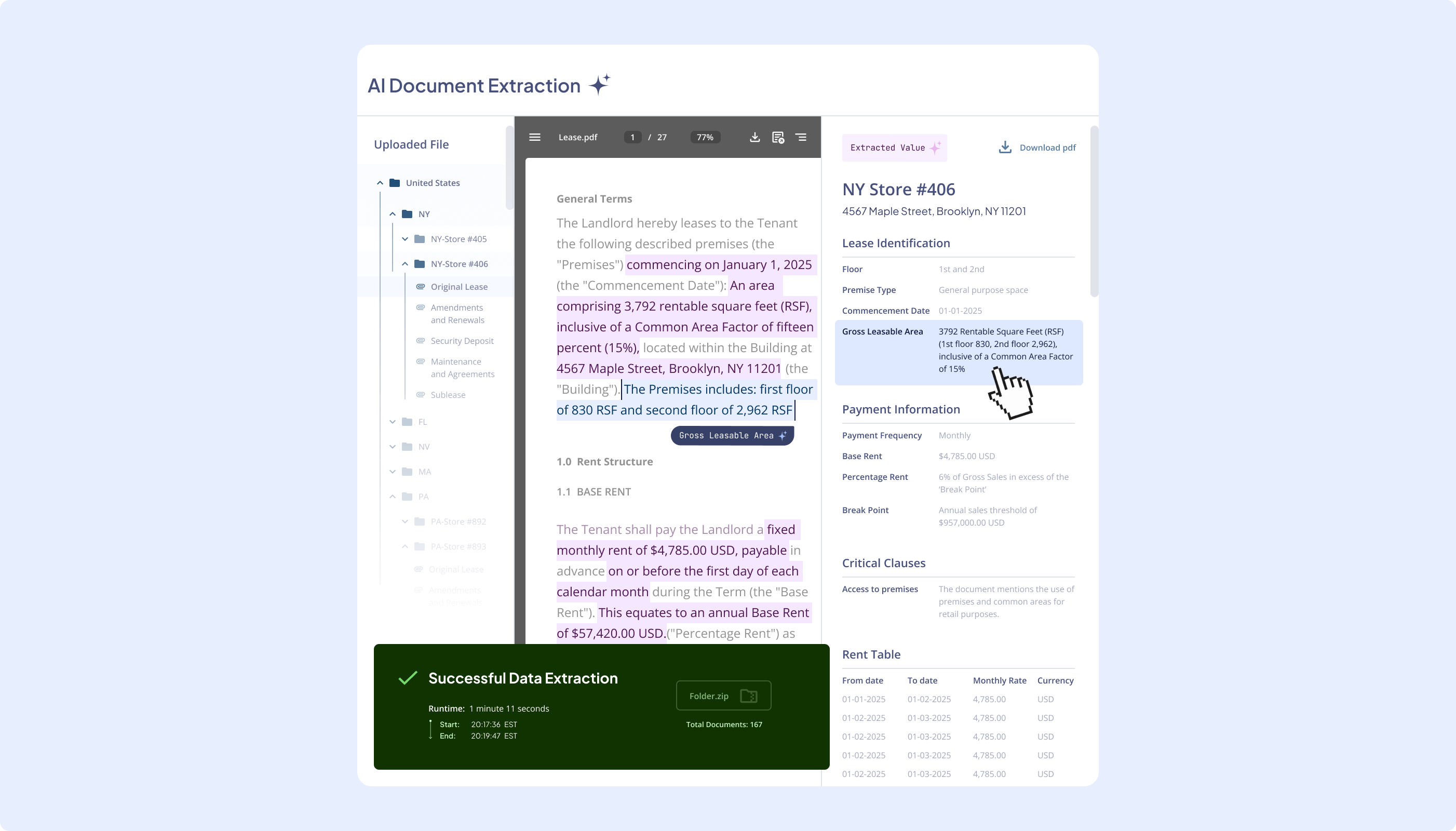
Upload multiple documents and let Nakisa AI abstract them. You’ll see the extracted key data alongside the original document for quick validation
- Nakisa’s virtual library consolidates all lease-related data into a single, centralized platform, ensuring no detail—such as rent escalation clauses, renewal options, or financial obligations—is overlooked. Contract managers can easily search, tag, and view all documents associated with specific leases in one place. This centralization eliminates the risk of manual tracking errors and ensures that critical information is easily accessible to stakeholders worldwide.
- Internal coordination: Lease negotiations can be time-consuming, involving input from multiple departments across various regions. Nakisa IWMS accelerates this process with automated workflows, role-based access, and real-time collaboration tools. This enables teams to negotiate efficiently while maintaining full transparency and control. All negotiation-related documents are stored in an organized, centralized repository, accessible to authorized users. This not only simplifies the negotiation process but also ensures a clear audit trail for future reference.
- Timeline management: Nakisa IWMS tracks and flags critical dates, such as negotiation deadlines, renewal windows, and payment schedules. Assignees will receive in-app notifications and email reminders to ensure they don’t miss any critical date.
These features help contract managers gain the visibility and confidence to approach lease negotiations strategically. Centralized tracking and organization ensure that every lease detail is easily accessible and set up for a seamless transition into the next phase—operating and monitoring leases, which we’ll cover more in depth in the next section, after looking at common challenges retailers would face while leasing, financing and building.
Jane Yi
Financial Analyst at EMCO

Operating and monitoring leases and facilities
Once leases are active, the focus shifts to managing their day-to-day operations while ensuring compliance with financial and contractual obligations. This stage involves tracking lease payments, monitoring critical dates, and ensuring adherence to financial reporting standards like IFRS 16, ASC 842, and local GAAP. For global retailers managing large and complex portfolios across multiple regions, maintaining visibility and control over lease performance is a critical challenge. Effective lease management is essential for optimizing costs, reducing risks, and driving operational efficiency—especially when dealing with intricate lease structures, varying payment models, and strict compliance requirements.
Let’s explore these challenges in more detail and how an IWMS solution like Nakisa can address them.
Challenge 6: Managing large, global, multi-asset retail portfolios
Global retailers face the complexity of managing a geographically dispersed portfolio. Each contract may have unique terms, regional compliance requirements, and operational nuances that must be coordinated across different time zones, currencies, and local regulations. As portfolios grow, centralized oversight and streamlined processes become critical to ensure consistency, efficiency, and strategic alignment. Without the right tools, organizations risk inefficiencies, data silos, and missed opportunities to optimize their assets.
Handling high contract volumes and manual lease data challenges
Global retailers often manage hundreds, or even thousands, of lease contracts. Each lease may come with its own set of terms, payment structures, escalation clauses, and renewal dates. Relying on manual management or spreadsheets is not only inefficient but also increases the risk of errors, missed deadlines, and non-compliance with contractual obligations. Legacy systems struggle to keep up with the complexity and volume of contracts, leaving retailers vulnerable to operational inefficiencies and financial discrepancies. A centralized enterprise-grade system is essential for tracking, analyzing, and reporting on extensive lease portfolios in real time to minimize operational costs and regulatory risks.
How Nakisa IWMS automates large-scale lease portfolio management
In Nakisa IWMS, the Portfolio Management Suite offers powerful lease management and accounting capabilities that address the complexities of managing large, global portfolios for retailers. Built on a cloud-native, innovative platform, Nakisa’s software easily handles complex portfolios of 300,000+ contracts from inception to termination.
With AI-driven automation and mass operations, Nakisa IWMS reduces manual work at all the stages of lease management.
- Centralized contract management: Nakisa’s virtual library consolidates all lease-related data into a single platform, ensuring no detail is overlooked. Nakisa organizes commercial real estate data into three intuitive levels: location, premise, and contract, ensuring seamless management and navigation. Retailers often manage multiple contracts for a single location, including head leases and various service agreements (e.g., security, maintenance). Nakisa allows teams to track and manage multiple contracts under a master lease agreement, providing a comprehensive view of all associated agreements, conditions, and payment processes at the premises level.
Additionally, users can attach lease contract files in various formats, ensuring easy access to original agreements when needed. Contract managers can easily search, tag, and view all documents associated with specific leases in one place, improving visibility and control while reducing the risk of missing obligations. Automatic alerts and email reminders help contract managers stay on top of critical dates, pending activations, renewal or termination deadlines, payment schedules, and more. The software enables retailers to efficiently manage, track, and reconcile all contracts within a unified platform, enhancing accuracy and control over their financial and operational obligations across different locations while ensuring seamless lease management and compliance. - Nakisa AI Document Abstraction: The tool enables rapid and accurate identification and abstraction of key fields in lease agreements and invoices. It allows for mass document abstraction, quick validation, and export of abstracts to eliminate manual work and reduce the risk of errors.
- Nakisa AI Agents: Leveraging cutting-edge agentic AI, Nakisa develops AI agents that significantly enhance operational efficiency for global retailers. For example, one AI agent assists with sales-based formula creation: contract managers just input the terms and conditions of the sales-based rent in plain English, and the agent automatically generates the corresponding Excel-like formula for the engine. Another AI agent simplifies the creation of custom dashboards—users can describe their requirements, and the agent designs a tailored dashboard that meets their specific needs.
- Automated mass and batch operations: The platform’s powerful mass data import capabilities streamline data entry, while incorporating format validation and error handling to help users quickly identify and resolve data discrepancies. The mass event management tool enables bulk modifications to lease components, simplifying updates to terms and ROU asset values. Contract managers just need to filter leases and contracts they want to apply changes for and schedule a mass modification job. Bulk integration automates tasks like transaction postings, workflows, and asset remeasurements, saving time for portfolios with hundreds of leases. Mass reversals and period adjustments allow accurate historical updates, while the job posting scheduler automates month-end activities with detailed logs for real-time tracking. This allows for efficient management of large volume of contracts while reducing the potential for errors, crucial to retailers with extensive global holdings.
- Automated calculations for both lease and non-lease expenses: Nakisa’s engine create rent tables and generates journal entries based on contractual agreements. Once the contract terms and conditions are entered into the system, the system automatically calculates variable rent payments and assists in reconciling contractual with actual expenses.
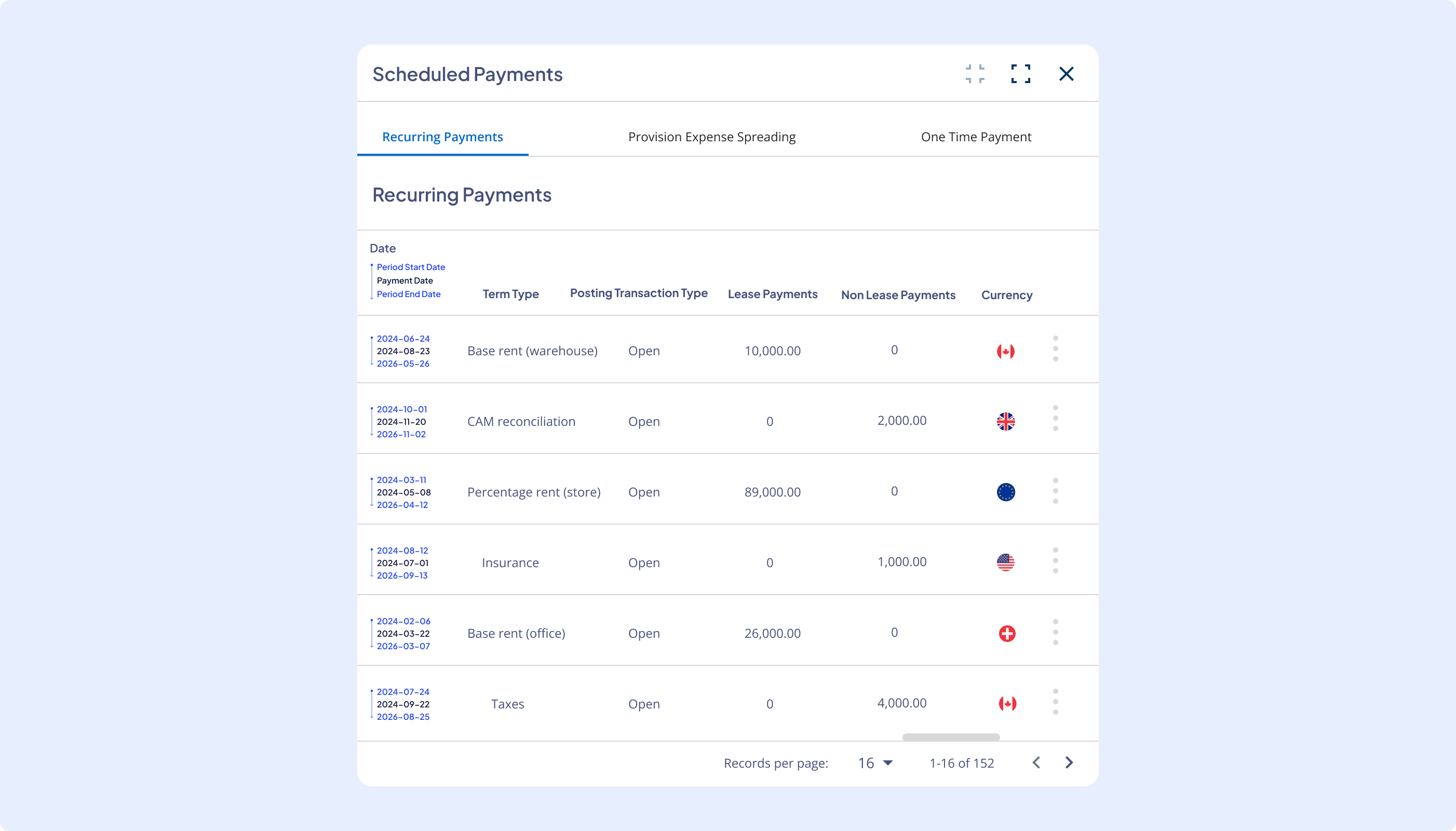
Based on contractual agreements, Nakisa Portfolio Management software schedules recurring and one-time payments for lease and non-lease expenses.
Managing multi-asset retail portfolios
Managing multi-asset portfolios, including properties, equipment, land, and fleets, presents significant challenges for large retailers. Each asset type requires unique management, maintenance, and compliance processes. For instance, properties demand lease administration and CAM reconciliation, equipment necessitates lifecycle tracking, and fleets require route optimization and maintenance scheduling. The complexity increases as retailers must consolidate and analyze vast amounts of data across these diverse asset categories, often stored in disparate systems, making it difficult to gain a unified view of the portfolio.
Additionally, retailers must manage both leased and owned real estate assets, ensuring proper oversight of lease obligations while also tracking owned property usage, associated costs, and maintenance requirements. Without a centralized approach, this can result in fragmented data, making it harder to optimize space utilization and financial planning.
Accurate cost allocation further complicates matters, as retailers need to distribute expenses, such as maintenance costs or property taxes, across multiple assets and locations, a process that can be both time-consuming and prone to errors.
Scalability is another concern, as managing a growing portfolio with diverse asset types becomes increasingly challenging when trying to align operational efficiency with strategic goals. Furthermore, the lack of integration between systems managing different asset categories often leads to inefficiencies and data silos, hindering cross-portfolio visibility and effective decision-making.
How Nakisa IWMS centralizes multi-asset portfolio management
Nakisa IWMS addresses the complexities of managing multi-asset portfolios by providing a centralized platform that streamlines the management of any tangible asset, including properties, equipment, land, and fleets. It automates lease administration tasks such as CAM reconciliation and percentage-based rent for properties while facilitating lifecycle management and inventory tracking for equipment and optimizing fleet operations through granular lease structure from master lease agreement to activation group and unity-level.
Nakisa enables organizations to manage all owned, leased, and subleased assets within the same platform. This holistic approach eliminates data silos and enhances decision-making by providing a complete portfolio overview. Retailers can easily manage premises for their owned real estate assets and track all documents and asset-related expenses from a single platform, ensuring full visibility of their property footprint.
With Nakisa, retailers can ensure compliance with various regulatory requirements across asset types, including adherence to lease accounting standards like IFRS 16, ASC 842, and local GAAP. The platform provides true asset-level accounting, enabling retailers to track and manage individual assets within a single contract. This level of granularity ensures precise cost allocation, depreciation tracking, and reporting, reducing potential errors in financial reporting and ensuring compliance with accounting standards.
Optimizing global portfolio management: parallel accounting standards, multi-currency, multi-calendar, and multi-language support
Managing leases across numerous locations adds layers of complexity—especially when each region has its own specifics.
- Compliance requirements, financial standards, and tax implications: A retailer's portfolio could span several countries with different lease regulations that impact lease agreements. Retailers need a system that consolidates information from various locations while ensuring compliance with international and local standards (such as IFRS 16, ASC 842, and local GAAP), tax codes, and landlord obligations. As the portfolio grows, maintaining visibility into these leases and ensuring consistency across regions becomes even more critical. The lack of a centralized system offering parallel compliance can result in fragmented data, inefficiencies, and errors, ultimately hindering a retailer's ability to achieve compliance, make data-driven decisions, and optimize their global portfolio.
- Multi-currency translation: Global retailers often deal with leases in different currencies. Each contract may be negotiated in a local currency while the company's financial operations are conducted in a different corporate currency. This divergence complicates lease payments, financial reporting, and budgeting—especially when currency fluctuations impact expected costs. Retailers require a system that seamlessly handles multi-currency agreements to ensure accurate tracking of payments in different currencies and conversions when necessary. Furthermore, the system should generate consolidated financial reports in the corporate currency while allowing localized reporting in relevant lease currencies. This flexibility ensures retailers can maintain financial clarity and consistency across diverse markets and contracts while minimizing risks associated with exchange rate movements.
- Multi-calendar management: Retailers often face challenges managing leases with different calendar systems. Different countries or regions may follow distinct fiscal years, such as a calendar year (January to December) or a fiscal year that ends in March. Leases may involve multiple parties—such as tenants and landlords—who follow different calendar systems or fiscal periods. Local holidays, market-specific calendars, and lease-specific terms (e.g., anniversary dates for rent escalations or renewals) can further complicate matters.
Additionally, many retailers adopt non-standard accounting calendars that align financial reporting with seasonal and operational cycles rather than traditional monthly or quarterly schedules. Examples include the 4-4-5 calendar, which divides each quarter into three months with four, four, and five weeks respectively, totally 13 weeks per quarter; the 4-5-4 calendar, which follows a similar structure but allocates five weeks to the second month of each quarter; and the 13-period calendar, which splits periods to four weeks each, ensuring uniform reporting periods. These misalignments can complicate lease payment schedules, budgeting, reconciliation, financial reporting, and renewals. Global retailers need a system that integrates multi-calendar functionality, enabling them to manage lease obligations seamlessly across different periods and avoid confusion and delays arising from these discrepancies. - Multi-language management: In global operations, retailers often manage leases in different languages. This adds complexity in interpreting legal terms, financial obligations, and renewal clauses. Misunderstandings or incorrect translations can lead to contractual disputes, payment errors, or compliance issues. Furthermore, managing leases in multiple languages increases the administrative burden on teams who must ensure accurate and consistent data across all regions. A centralized system that supports multi-language capabilities is essential for avoiding errors and streamlining global lease management.
How Nakisa IWMS helps retailers manage global portfolios
- Multiple jurisdictions: Nakisa IWMS supports multi-location management by ensuring that each lease adheres to the relevant accounting practices, tax regulations, and compliance standards, such as IFRS 16, ASC 842, and local GAAP. This capability allows retailers to maintain consistent reporting across regions while staying compliant with diverse requirements. The platform integrates seamlessly with ERP systems, helping align financial reporting for global operations, improving visibility, and reducing the risk of errors.
- Multi-currency translation: Nakisa’s multi-currency support enables retailers to handle complex lease calculations and payments, including sales-base rent, across various currencies, while ensuring compliance with local as well as international regulations and accounting standards. The system tracks lease calculations and rent payments in different currencies, automatically converts them into the company’s reporting currency, and accounts for exchange rate fluctuations, ensuring precise financial reporting and streamlined lease management.

Alanna Bilben
Business Transformation IT RTR Lead at 3M
- Multi-language support: Nakisa IWMS offers multi-language functionality (English, French, Spanish), enabling retailers to operate seamlessly across global teams with diverse language needs. This feature ensures that all users, regardless of their location, can access lease information in their preferred language, improving communication and reducing errors. It supports global operations, making compliance with local regulations more efficient and enhancing the overall user experience for multinational teams.
- Multi-calendar support: with Nakisa’s multi-calendar functionality, retailers can seamlessly manage leases across various market-specific calendars and fiscal periods, including standard and non-standard formats like 4-4-5, 4-5-4, 360, and custom calendars. This ensures that lease payment schedules, renewals, rent escalations, and financial reporting align precisely with both company policies and regional requirements. By accommodating diverse fiscal structures, this feature helps prevent misalignments in payments or reporting, reducing errors and enhancing operational efficiency across multiple regions. Additionally, Nakisa allows users to create fiscal variants for each legal entity, offering flexibility tailored to industry-specific needs and global operations.
Overall, Nakisa IWMS offers global retailers a comprehensive, flexible, and robust solution for managing and operating extensive portfolios. By enhancing visibility, ensuring accuracy, and supporting compliance, it serves as an essential tool for retailers aiming to optimize their global asset management strategies.
Rodolfo Etelwof Juarez Arevalo
IFRS and Accounting Policies Manager at Unicomer Group
Challenge 7: Managing complex lease structures in retail operations
Retailers face significant challenges in managing complex lease structures, especially subleases and sandwich leases. Each lease comes with unique terms that demand careful tracking and coordination. Without effective management, these complexities can lead to financial penalties, missed opportunities for renegotiation, or even disputes, making it crucial to address them proactively.
Handling embedded leases
Embedded leases refer to lease components often hidden within broader service contracts such as logistics or maintenance agreements, making them hard to track. Due to this lack of visibility, retailers may unknowingly fail to account for these embedded leases, leading to substantial legal and compliance risks, particularly under accounting standards like ASC 842 or IFRS 16, which require leases to be capitalized on the balance sheet.
Managing embedded leases is time-consuming and complex. Once identified, the lease and non-lease components must be accounted for separately. Retailers’ long-term outsourcing agreements often evolve, requiring accountants to monitor changes affecting embedded lease accounting.
How Nakisa simplifies embedded lease tracking
Nakisa simplifies embedded lease management by providing a centralized platform where retailers can track both the lease itself and any related service or maintenance agreements as non-lease expenses. Instead of manually separating embedded lease components across different systems, Nakisa ensures that all contractual obligations—whether lease-related or service-based—are managed in one place.
Once an embedded lease is identified, Nakisa automatically classifies the lease component for capitalization under IFRS 16 or ASC 842 while recording related service and maintenance agreements as non-lease expenses. This structured approach ensures accurate financial reporting by correctly allocating payments, preventing misclassification, and maintaining compliance. Additionally, Nakisa allows finance teams to track cost fluctuations, renewal terms, and contract modifications over time, ensuring that both lease and service costs are fully accounted for throughout the contract lifecycle.
With Nakisa, retailers gain a single source of truth for managing embedded leases, reducing manual effort, eliminating data silos, and ensuring a clear distinction between lease and non-lease financial commitments.
Managing subleases and sandwich lease structures
Retailers who act as both tenants and landlords face a unique set of challenges, requiring them to manage two different sets of responsibilities. Balancing these roles demands a deep understanding of lease agreements, financial obligations, and operational efficiency.
As a tenant, retailers must ensure compliance with lease terms, including rent payments, common area maintenance (CAM) charges, property taxes, and insurance premiums. At the same time, as a landlord, they must track income from tenants, manage lease escalations, and ensure property maintenance according to lease agreements. This dual responsibility increases administrative complexity, as both income and expenses must be effectively managed and aligned.
Subleasing adds further complexity, particularly in sandwich lease arrangements where the retailer leases property from an owner and then subleases it to a third party. This scenario requires handling separate obligations for both the primary lease (tenant) and the sublease (landlord), with distinct accounting treatments for each role.
From a lease management perspective, subleasing requires aligning payment schedules, monitoring compliance with local laws, and managing obligations to both the landlord and the subtenant. From a lease accounting perspective, this dual role necessitates separate accounting treatments for the lease liability (as a lessee) and lease income (as a lessor), further complicating financial reporting. Subleasing often necessitates the reassessment of the ROU asset and lease liability. Additionally, if the terms of the original lease are modified to accommodate subleasing, retailers must perform additional calculations to ensure compliance with lease accounting standards such as IFRS 16 and ASC 842.
Without a proper, centralized system in place, these multi-layered arrangements can lead to discrepancies, financial instability, and compliance risks. This makes it crucial for retailers to adopt robust tracking and management tools to stay on top of their subleasing commitments while ensuring transparency in financial reporting.
How Nakisa IWMS streamlines sublease and sandwich lease management
Nakisa IWMS is purpose-built for global retailers. The Portfolio Management Suite provides robust capabilities to effectively manage complex lease structures, including lessor, lessee, and sublease functionality.
For retailers managing both lessee and lessor roles, Nakisa IWMS provides a centralized platform for end-to-end lease management and accounting. This includes automating the separation of lease liability (as a lessee) and lease income (as a lessor), ensuring compliance with IFRS 16 and ASC 842 through appropriate accounting treatments. Nakisa's lessor accounting module supports operating leases, allowing retailers to manage any asset with precision. The module streamlines event management for individual and bulk leases, handles modifications efficiently, and provides automated financial schedules, periodic postings, and detailed reports to enhance lease portfolio management.
Nakisa IWMS serves as a centralized repository for storing and managing all lease agreements, facilitating efficient tracking of both primary leases and subleases. Retailers can generate lessor leases to easily track and administer subleased assets. The software then automatically recalculates the ROU asset and lease liability, ensuring that these components accurately reflect the subleased portion of the asset. The software allows for the management of subleased areas (square meters/square footage), adding an extra layer of granularity that saves time and improves accuracy.
Nakisa IWMS simplifies the management of sandwich leases by enabling retailers to create two contracts for the same location, one for the head lease and another for the sublease, while maintaining full control over lease terms and ensuring compliance from subtenants. Retailers can easily compare clauses in two contracts to spot discrepancies and inconsistencies. The platform also automates the reassessment of right-of-use (ROU) assets and lease liabilities when subleasing occurs, ensuring that financial components accurately reflect the subleased portions and eliminating the risk of errors.
Additionally, the software automatically adjusts for any modifications to original lease terms, such as those related to subleasing, reducing administrative effort and minimizing non-compliance risks. Nakisa generates separate invoices for landlords and subtenants, streamlining payment processes, and provides robust reporting capabilities for real-time visibility into lease and financial performance.
Nakisa IWMS also enhances sublease tracking and reporting with comprehensive dashboards and lessor-specific reporting tools, providing real-time visibility into subleased assets, lease income, and financial performance. Retailers can easily monitor sublease agreements, track payments, and analyze occupancy data through dashboards and automated reports that consolidate key lease metrics, including sublease revenue, lease modifications, and financial impacts.
With built-in audit trails and configurable reporting, Nakisa ensures full transparency, simplifies compliance, and enables data-driven decision-making for retailers managing subleased properties. These features empower retailers to make informed decisions while maintaining transparency and accuracy in their lease portfolios.
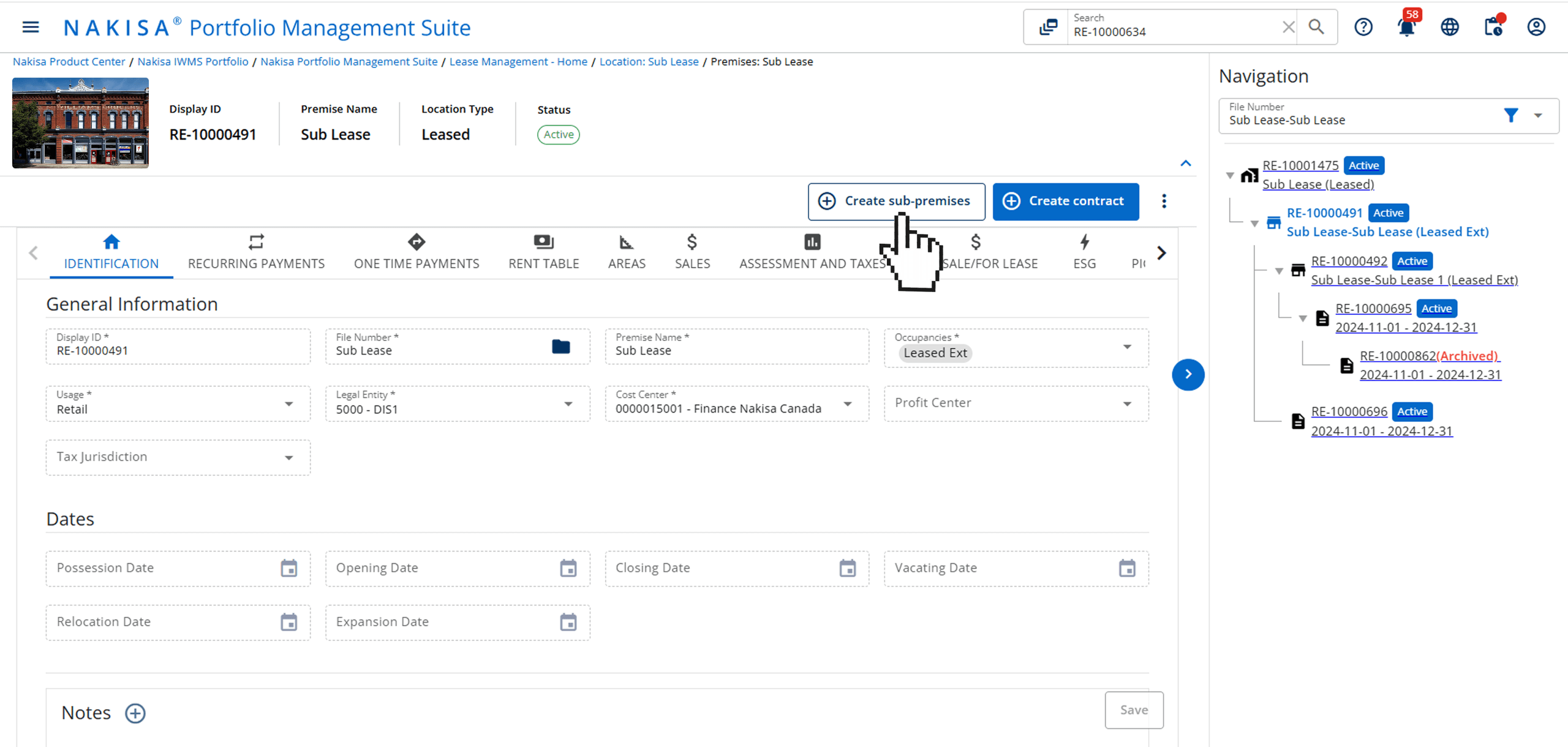
Nakisa Portfolio Management software makes sublease creation and management easy, thanks to its clear hierarchy of location, premises, and contracts.
Managing evergreen leases
Global retailers frequently use evergreen leases, particularly for retail store and product leasing agreements. These leases automatically renew for successive terms unless terminated. For example, a clothing brand may sign a five-year lease for a prime storefront with an automatic renewal clause, extending the lease for additional five-year terms unless either party provides notice to terminate. This offers stability and flexibility, allowing the retailer to maintain a presence in high-traffic locations without constant renegotiation. Similarly, retailers often lease space in shopping malls with automatic renewal provisions, ensuring continuity in desirable locations and minimizing operational disruptions. Retailers may also engage in evergreen leasing for products and fixtures, such as flooring.
These evergreen leases present unique challenges in both lease management and financial reporting. From a management perspective, retailers must carefully track lease terms, conditions, and payments for each renewal cycle. The indefinite duration of these leases complicates long-term financial planning, as the lease continues without a defined end date unless terminated.
In terms of accounting, evergreen leases require compliance with standards like IFRS 16 and ASC 842, which mandate the recognition of right-of-use (ROU) assets and lease liabilities. The continuous renewal process makes it difficult to assess the long-term financial impact. Additionally, managing lease modifications—such as changes in terms—and ensuring proper accounting for renewal periods becomes more complicated due to variations in regulations across jurisdictions.
Accurately identifying evergreen leases in an organization’s portfolio also presents a challenge. Retailers must review lease agreements to spot automatic renewal clauses. Failure to properly identify these leases can lead to unexpected financial commitments, operational disruptions, and difficulties in renegotiating favorable terms. Addressing these complexities requires robust systems and processes to ensure compliance and effective lease management.
How Nakisa IWMS enhances evergreen lease management with automated contract extension
Nakisa IWMS supports evergreen leases, enabling retailers to automatically renew lease agreements while ensuring compliance with accounting standards. Retailers retain control over which leases are extended, providing flexibility and oversight.
The solution automates month-to-month contract extensions after the original contract end date. This setting can be activated at lease inception or at any point during the lease term through contract versioning. Admin-level configurations direct all financial postings for these renewals to a non-lease expense category, simplifying tracking and reporting for leases extended beyond their contractual term. By automating this process, Nakisa ensures seamless payment generation without manual intervention. This not only streamlines lease management but also reduces administrative effort.
However, without proper oversight, the automatic renewal process can lead to extended lease periods without necessary review or renegotiation, potentially misaligning with current business needs or market conditions. Nakisa IWMS mitigates this risk by providing powerful reporting, customizable dashboards, and real-time lease status overviews. Contract managers can easily track leases that have switched to month-to-month extensions and conduct timely reviews. Additionally, automated reminders and alerts notify contract managers in advance of upcoming renewal dates, facilitating proactive reviews and adjustments.
Regularly assessing evergreen lease terms and market value ensures retailers remain in control, allowing them to take timely actions—whether adjusting or terminating leases—to avoid unforeseen financial or operational impacts.
Overall, Nakisa IWMS empowers global retailers by providing a comprehensive solution for managing complex lease structures efficiently. With its advanced features for automation, compliance tracking, and real-time reporting, Nakisa enhances operational efficiency, ensuring their long-term success in a dynamic marketplace.
Challenge 8: Managing complex fixed and variable rents
For retailers, managing complex lease agreements is a significant challenge, particularly when dealing with percentage rent leases and escalating rent structures across a vast network of stores. With multiple locations and varying lease terms, accurate rent calculation and forecasting are critical to maintaining financial accuracy and lease compliance. Without the right tools, managing these complexities can lead to errors, financial inefficiencies, and strained landlord-tenant relationships.
Simplifying percentage and sales-based rent management
Percentage rent leases, where tenants pay a percentage of their sales (often gross sales) in addition to a base rent, are common in retail. The percentage applied may vary across different sales ranges or product categories, adding layers of complexity to the calculation process. While this structure can be beneficial for both tenant and landlord, it introduces several challenges. Retailers must accurately track fluctuating sales performance data, which can vary due to seasonal demand, location, and other factors.
Calculating the correct rent can be complex, especially for retailers managing multi-location lease agreements. Any inaccuracies in sales tracking or rent calculations can result in disputes with landlords and potential financial losses.
Furthermore, many leases with variable rent terms require periodic reconciliation (true-ups) based on actual sales data. Retailers must ensure these adjustments are processed correctly and in a timely manner. Inaccurate reconciliations can distort lease obligations, leading to discrepancies in financial statements that may trigger non-compliance with relevant accounting standards.
Ensuring timely and accurate rent payments often requires automated rent tracking tools to capture and analyze sales data in real time.
How Nakisa IWMS automates complex variable rent calculation and management
Nakisa IWMS streamlines calculation, tracking, reconciliation, and payment of complex percentage rent scenarios. The software automates percentage rent calculations based on actual sales data, which can be uploaded manually, through an Excel template, or API integration with POS systems. Contract managers can define complex percentage rent formulas specific to their business needs. These formulas can include if-else statements, comparison operators, minimum and maximum values, absolute values, excluded categories, and more. They can integrate variables such as total sales, sales per category, days in period, or days in adjusted period into calculations, providing unmatched flexibility to accommodate diverse rent structures and financial arrangements unique to each business requirements.
What’s more, Nakisa AI Agent for variable rent calculation can assist with formula creation—contract managers need just to enter the contractual obligation in a chat, and the AI Agent will generate the correct formula for the system.
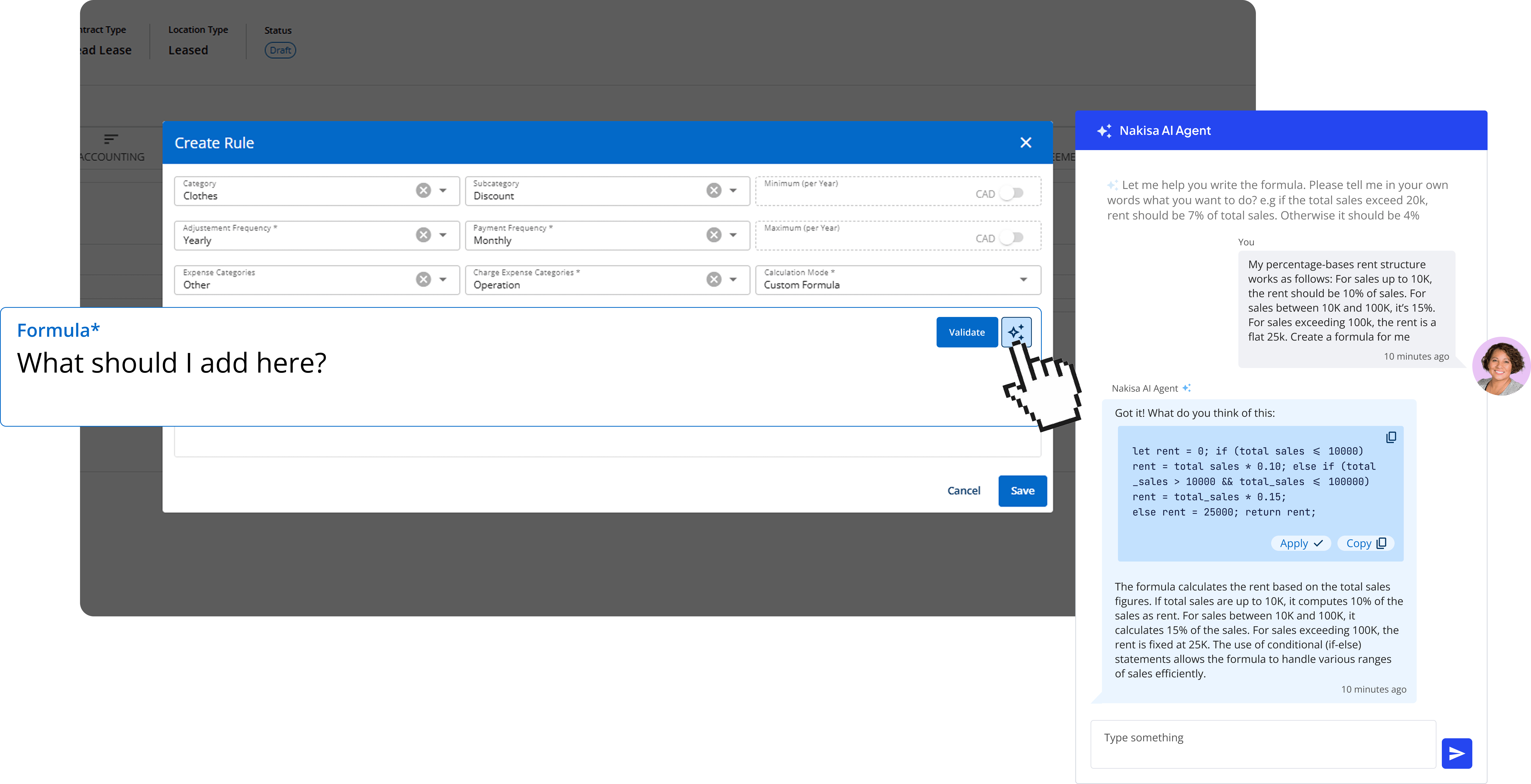
Nakisa AI Agent simplifies complex variable rent calculations by converting lease terms into accurate, ready-to-use formulas.
Real estate professionals can create batch work to generate multiple percentage rent calculations simultaneously, further enhancing efficiency. The system also supports multi-currency transactions to eliminate manual calculation errors and reduce the administrative burden for retailers with extensive portfolios.
Nakisa IWMS also offers the reconciliation of rent adjustments, ensuring that any variances between estimated and actual sales are captured and corrected in a timely manner. This feature automates the true-up process, reducing the risk of underreporting or overreporting rent obligations.
Furthermore, by automating percentage rent calculations and ensuring timely reconciliations, Nakisa prevents discrepancies in financial statements, ensuring accounting compliance such as IFRS 16 and ASC 842. This allows lease accountants to maintain the accuracy of their financial reporting, even when rents fluctuate based on performance.
Managing escalating rent across retail locations
Rent escalation clauses, which allow for periodic rent increases throughout the lease lifecycle, are crucial for ensuring rental income keeps pace with contractual agreements and evolving market conditions. Types of rent escalation include fixed escalation, where a pre-determined increase in rent happens as specified intervals (for example, 2.5% increase per year), Consumer Price Index (CPI)-based adjustments, where the rent increase is tied to the CPI to reflect inflation rates, or operating expense escalation, where tenants pay additional rent to cover rising property expenses like maintenance or taxes (this is especially relevant for commercial leases where property costs might fluctuate).
For retailers with large real estate portfolios, managing escalation clauses across multiple locations presents significant challenges. Without a robust centralized system to track and automate these adjustments, retailers risk overpaying or missing rent adjustments, facing compliance issues, and encountering financial discrepancies. Additionally, precise forecasting and tracking of rent increases is crucial to ensure lease liabilities and right-of-use (ROU) assets reflect current terms, avoid errors in financial statements, and maintain compliance with IFRS 16 and ASC 842 accounting standards.
Market volatility adds another layer of complexity, as fluctuating conditions can affect the fairness and applicability of escalation clauses, necessitating regular review of terms, potential renegotiation of agreements, and adjustment of financial projections and reports. Varying legal requirements for rent increases across locations, currency fluctuations affecting escalation calculations, and diverse market conditions influencing fair escalation rates add to this complexity for global retailers.
Lease modifications, such as renewals or terminations, may also trigger changes in escalation terms, requiring recalculation of lease liabilities and ROU assets. This process demands careful oversight to prevent delays or miscalculations and ensure timely updates to financial reports for maintaining compliance.
Effective management of rent escalation clauses requires robust lease management systems, diligent oversight, and a thorough understanding of both local market conditions and global accounting standards.
How Nakisa IWMS automates escalating rent calculation and management
In Nakisa IWMS, the Portfolio Management Suite automates escalation clause calculations, ensuring rent changes are accurately tracked, applied, and forecasted. Its formula-based CPI computation supports custom global CPI categories that blend multiple CPI inputs with specific weights, addressing regional requirements for composite CPIs. During renewals or terminations, Nakisa quickly recalculates lease terms adjusting for new escalation clauses or rent changes to ensure compliance and accurate lease obligations and ROU assets.
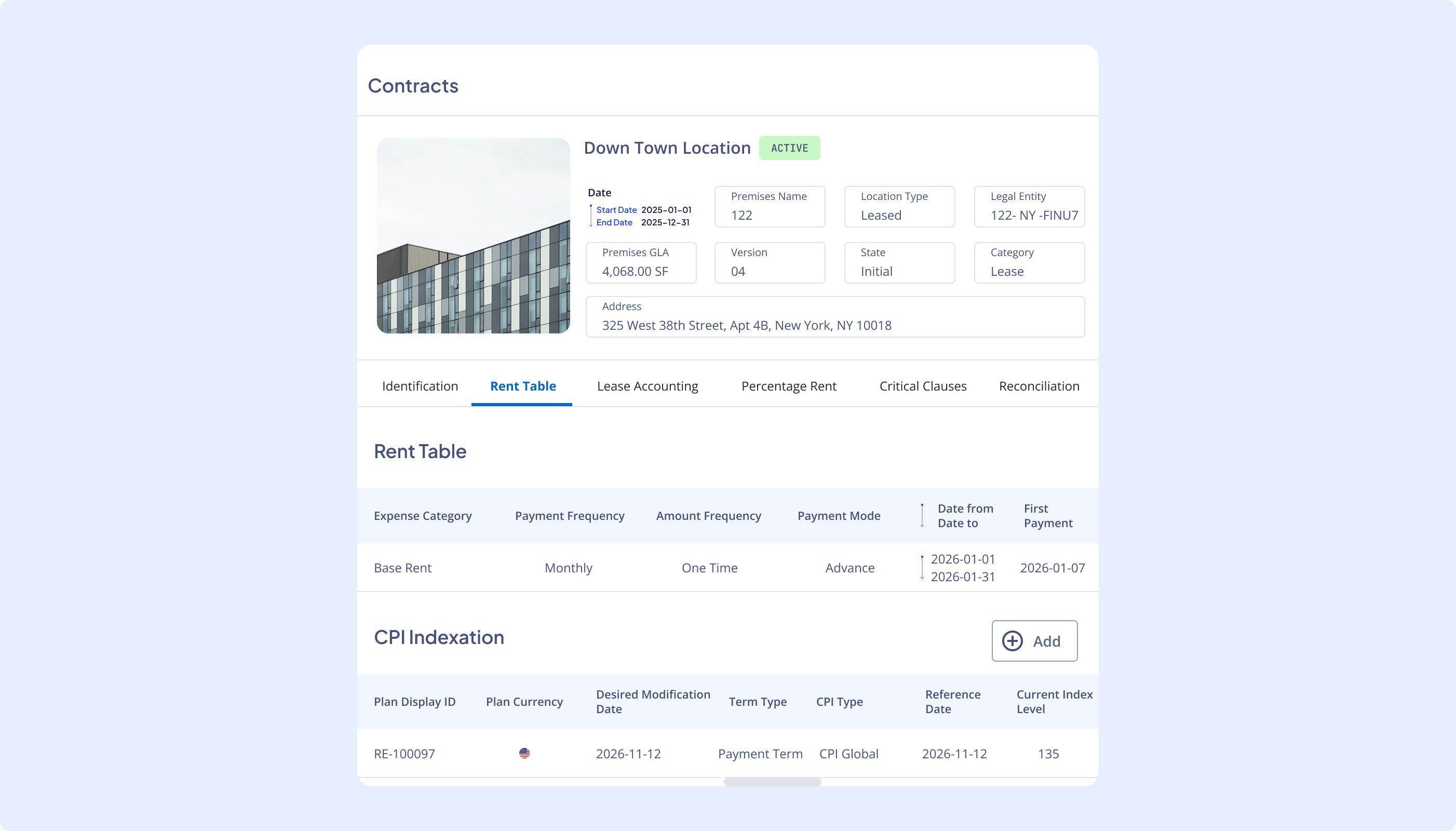
Nakisa Portfolio Management software supports custom global CPI categories to ensure compliance and accurate lease obligations.
Additionally, with its powerful financial simulations and forecasting scenarios, Nakisa allows businesses to proactively assess the impact of future rent changes. This functionality empowers retailers to make informed, strategic decisions and select the most advantageous terms and conditions, ensuring that lease agreements align with both current and future financial goals.
With Nakisa’s direct integration of escalating rent into payment terms, retailers can specify how often and how much the rent changes over time, accommodating various scenarios including negative and positive adjustments, as well as amount/percent base calculations with carry-forward logic for existing contracts. This flexibility enables retailers to manage diverse rent structures efficiently across their portfolio.
Nakisa also ensures compliance and accuracy by providing a comprehensive audit trail for all escalation-related changes, which is crucial for audit purposes and maintaining financial integrity. As escalation clauses take effect, Nakisa updates lease liabilities and right-of-use (ROU) asset calculations in real-time, ensuring that the financial statements reflect the most current terms.
Advanced reporting and dashboards provide detailed insights into rent trends, helping retailers monitor performance across locations, quickly identify discrepancies, and make informed financial decisions.
By offering these comprehensive features, Nakisa IWMS addresses the intricate challenges global retailers face in managing complex fixed and variable rent calculations, transforming a traditionally complex process into a streamlined, accurate, and strategic financial management approach.

Eric Cabana
Senior Real Estate Advisor at TC Transcontinental
Challenge 9: Managing lease reassessments for global retailers
Lease reassessments are a critical yet challenging aspect of lease management for global retailers, triggered by events such as lease extensions, terminations, renewals, or impairments. Each scenario introduces operational complexities that require careful evaluation and adjustments to financial plans. For example, lease extensions may impact rent escalations, early terminations may result in exit penalties or asset write-offs, and renewals demand alignment with market rent conditions and business goals. Impairments, on the other hand, require reassessing underperforming locations to ensure accurate financial reporting.
For retailers with extensive, geographically diverse lease portfolios, managing lease reassessments effectively is essential to maintaining compliance with varying accounting standards (such as IFRS 16, ASC 842, and local GAAP), minimizing costs, and supporting long-term growth strategies in different markets.
- Lease renewals: Lease renewals involve negotiating new terms for a subsequent lease period. Renewal clauses provide flexibility, allowing extensions under predetermined terms or market-adjusted rates. These clauses vary significantly between agreements, with some offering multiple renewal options and others none at all. Managing renewals at scale presents challenges, including fluctuating rents, ambiguous renewal procedures, and the risk of missed deadlines, leading to automatic renewals, lost renegotiation opportunities, unfavorable lease terms, cost escalations, or forced relocations, all of which impact a retailer’s bottom line and operational strategy.
- Lease extensions: A lease extension continues the current lease under its existing or slightly modified terms for an additional period. Lease extensions require recalculating the lease term and adjusting key financial components, such as the right-of-use (ROU) asset and lease liabilities. These extensions often affect future payments such as rent escalations and variable rent payments. Accurately assessing whether an extension is a practical option or contractual obligation is essential for lease accounting compliance and maintaining clear, accurate financial reporting. Global retailers must navigate these adjustments while considering location performance, market conditions, currency fluctuations, and long-term business objectives. Efficient tools automate assessments, enabling retailers to evaluate extension terms and their financial implications, avoid overcommitting to underperforming locations, and mitigate compliance risks caused by inaccurate calculations, all while aligning decisions with portfolio performance and financial goals.
- Lease terminations: Lease terminations require retailers to assess the remaining lease term, update lease liabilities, and account for early exit penalties or adjustments outlined in the agreement. Terminations may also involve impairments of the ROU asset, which must be accurately reflected in financial statements to ensure compliance with standards such as IFRS 16 or ASC 842. Decision on lease termination requires analyzing store performance, market dynamics, and the financial impact of exit penalties. Retailers must carefully balance short-term termination costs with long-term strategies like relocating operations or consolidating underperforming stores. Without advanced tools, they risk prolonged negotiations, errors in financial adjustments, and missed opportunities.
- Lease impairments: Lease impairments occur when the carrying value of a right-of-use asset exceeds its recoverable amount, often due to underperforming or strategically obsolete locations. For global retailers, evaluating impairments involves monitoring store profitability, market conditions, and the asset’s ability to generate future economic benefits. Accurate impairment calculations are critical to maintaining compliance with financial reporting standards and minimizing risks of overstated asset values. Given the volume and diversity of locations in a retailer’s portfolio, manual impairment assessments can be time-consuming and error-prone. Leveraging technology to automate these calculations allows retailers to quickly identify underperforming assets, adjust financial records accordingly, and make data-driven decisions about their lease portfolio.
- Lease indexations: Widely used in commercial real estate, lease indexation adjusts rent periodically based on an external index, such as the Consumer Price Index (CPI) or other inflation-related measures. For landlords, it protects against inflation, especially in long-term leases. For tenants, it offers transparency and predictability, as adjustment terms are predefined. Common types include CPI-based leases, step-up leases (fixed increases), and hybrid models. While beneficial, indexation can present challenges, including tenant uncertainty during periods of high inflation, potential disputes over calculation ambiguities, and regulatory constraints. Under IFRS 16 and ASC 842, retailers must reassess lease liabilities and ROU assets whenever index-linked rent changes occur. Modern software solutions streamline and automate rent calculations, mitigating these issues and ensuring accuracy.
- Buy-out options: Buy-out options provide lessees the flexibility to purchase a leased asset— such as a vehicle or property—either during or at the end of the lease term, often at a price below its fair market value. This usually involves paying the asset’s residual value, plus applicable fees or taxes. The most common type is a lease-end buy-out, which allows purchase at the end of the lease term, especially advantageous when the asset's market value exceeds the residual value. Lease-end buy-outs can also help avoid excess mileage or wear and tear fees in vehicle leases. Less common is the early lease buy-out, which allows purchase before the term ends. Though typically more expensive due to remaining payments and fees, this option can help avoid penalties or secure a valuable asset. Under IFRS 16 and ASC 842, retailers must assess whether exercising the buy-out option is "reasonably certain." Once exercised, the lease is reclassified as a finance lease, and the leased asset becomes an owned asset at the end of the term. This requires detailed forecasting of future cash flows, evaluating the likelihood of exercising the buy-out option and recalculating both the lease liability and ROU asset.
- Rent reductions: Rent reductions typically result from negotiations between landlords and tenants, often due to market conditions, financial difficulties, or business changes. Tenants may seek reductions during economic downturns or periods of reduced business activity, while landlords may agree to temporary or permanent cuts to retain tenants and avoid vacancies. In exchange, tenants might offer concessions like lease extensions or additional responsibilities. Rent reductions can also be part of lease restructuring during renewals or amendments. Both parties should document any changes clearly to prevent disputes. Tenants should review lease terms, understand market conditions, and present a compelling case for adjustments. Legal or real estate advisors can assist with negotiations.
For retailers, rent reductions may qualify as lease modifications, requiring adjustments to lease liabilities and ROU assets. These adjustments must reflect revised payment schedules, discount rates, and any changes in lease terms, ensuring compliance and accurate financial reporting.
How Nakisa IWMS automates lease reassessments and modifications
Part of Nakisa IWMS, the Portfolio Management Suite offers powerful features that help retailers navigate the complexities of lease reassessment caused by key events such as renewals, extensions, terminations, impairments, indexations, buy-out options, and rent reductions. These events can be managed in bulk, with control and predictability across the whole portfolio, or handled individually, depending on the retailer's preferences. Nakisa's advanced automation and financial simulations streamline the entire process, reducing administrative workload and risk of errors.
Here's how Nakisa Portfolio Management streamlines lease reassessments:
- AI Document Abstraction: can be used not only for lease initiation, but also for lease reassessment and new contract versions. This feature simplifies the tracking of various lease terms, renewal options, and clauses, especially when dealing with multi-layered or non-standard lease structures. By centralizing all relevant lease information in one database, retailers can easily access critical details without relying on manual data entry. This not only reduces the risk of errors but also ensures that important lease obligations are never missed, enhancing both efficiency and compliance.
- Management of critical dates and clauses: Nakisa’s robust critical date and event tracking enables retailers to efficiently manage key lease lifecycle milestones, including renewals, extensions, terminations, impairments, indexations, buy-out options, and rent reductions. By providing automated real-time reminders, Nakisa ensures that lease reassessments are handled promptly and accurately, reducing the risk of automatic renewals, missed renegotiation opportunities, and unfavorable terms. Custom workflows engage all relevant stakeholders in the review process, helping to mitigate the risk of oversights. Additionally, Nakisa provides a comprehensive portfolio summary of due lease and non-lease payments, allowing for precise forecasting and budgeting across various timeframes, whether for the current month, next month, or the next 12 months. This proactive approach not only reduces administrative effort but also ensures compliance with accounting standards and helps retailers stay on top of critical lease events.
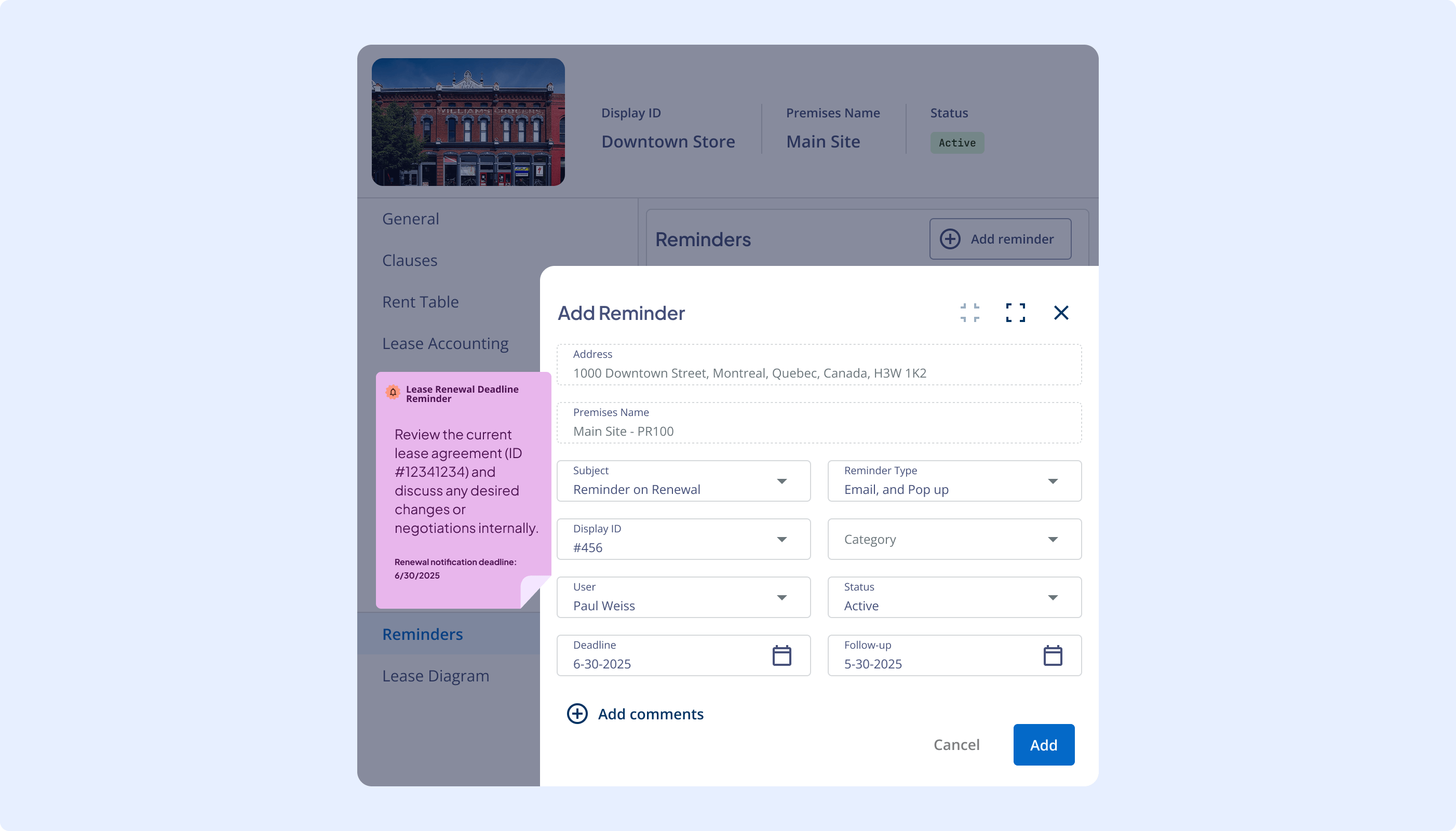
Easily configure email and in-app reminders for critical dates in Nakisa Portfolio Management.
- Scenario modeling and strategic budgeting: Nakisa IWMS includes powerful scenario modeling and strategic budgeting tools that allow retailers to simulate various lease scenarios and predict the financial impact of different reassessment options. This functionality helps retailers make informed decisions about lease renewals, terminations, or relocations and negotiate more favorable terms. By forecasting future lease obligations and aligning them with market conditions, retailers can optimize their portfolios and decide on the best course of action—whether extending a lease, terminating early, or renegotiating terms—to support long-term growth.
- Mass event management: Nakisa’s mass event management tool enables global retailers to efficiently handle high-volume lease adjustments by simultaneously updating lease components and activation groups in one streamlined process. Whether managing lease renewals, extensions, terminations, impairments, indexation, buy-out options, or rent reductions across multiple regions, the tool ensures that changes are applied seamlessly and consistently.
- Streamlined lease recalculation and adjustment: The platform’s advanced recalculation and adjustment tools automatically update lease liabilities and right-of-use (ROU) assets in response to critical lease events, ensuring ongoing compliance with accounting standards. These automated workflows enable retailers to efficiently recalculate and adjust lease data, eliminating manual intervention and maintaining precision in lease accounting. Additionally, the software generates detailed disclosure reports throughout the entire lease lifecycle, from initial recognition to reassessments, and lease terminations, further supporting compliance and accurate financial reporting.
- Automated month-to-month contract extension: When needed, contract managers can extend the contract on a month-to-month basis after the contract end date (right-of-use end date). A contract can be set for month-to-month renewal either at the lease inception or at any time of lease life through contract versioning. This auto-renewal process ensures continuity, reducing the need for frequent renegotiations while providing stability and convenience for both lessors and lessees.
- Automated accounting compliance check: Nakisa offers automated compliance checks for standards such as IFRS 16 and ASC 842, ensuring that all lease reassessments meet regulatory requirements. The software's impairment testing capabilities for right-of-use assets ensure accounting compliance, while its ability to handle retroactive adjustments is invaluable for addressing lease modifications affecting closed financial periods. This reduces the risk of non-compliance and simplifies audits, giving retailers peace of mind that their financial reporting remains both accurate and compliant.
Nakisa’s ability to manage complex lease structures across multiple locations reduces administrative burdens, avoids unexpected cost escalations, and mitigates the risk of forced relocations. Ultimately, it empowers retailers to optimize their portfolios while maintaining compliance and reducing operational risks.
Challenge 10: Automating lease reconciliations for global retailers
Expense reconciliation is a critical process to ensure transparency and accuracy in managing operating expenses. It involves verifying and settling variable costs such as Common Area Maintenance (CAM) charges, property taxes, and insurance payments. These costs, while essential for maintaining operational efficiency, can pose financial and operational challenges if not properly managed—especially across extensive real estate portfolios.
Automating common area maintenance (CAM) reconciliation
Common area maintenance (CAM) charges refer to the fees tenants pay to landlords for maintaining shared spaces, such as parking lots, lobbies, and landscaping. Landlords typically estimate CAM charges at the beginning of a lease term or fiscal year based on historical expenses, projected costs, or budgeting figures for maintaining shared spaces. These estimated charges are then divided into monthly payments, which tenants pay alongside their rent.
However, discrepancies often arise when the actual expenses differ from initial estimates. Through CAM reconciliation, landlords and tenants adjust these charges—either reimbursing tenants for overpaid amounts or billing them for underpayments. This process becomes increasingly complex for retailers managing multiple locations with unique lease clauses. Accurate CAM reconciliation is essential to maintain financial clarity, reduce disputes, and foster positive landlord-tenant relationships.
As we mentioned above, many retailers adopt non-standard accounting calendars that align financial reporting with seasonal and operational cycles rather than traditional monthly or quarterly schedules. Examples include the 4-4-5 calendar, 4-5-4 calendar, 5-4-4 calendar, 13-period calendar, and retail calendar. While these calendars simplify internal reporting and budgeting, they complicate lease reconciliation. Aligning CAM charges, rent payments, and other variable costs with a retailer’s fiscal cycles often requires customized processes and calculations, further complicating the reconciliation effort.
Additionally, under IFRS 16 and ASC 842, allocating between lease and non-lease components is crucial for accurate financial reporting and lease liability management. Retailers must therefore determine whether CAM costs should be classified as lease or non-lease components.
How Nakisa IWMS automates complex CAM reconciliation
Unlike other solutions on the market, Nakisa delivers CRE-specific functionality to automate the entire CAM reconciliation process, helping global retailers efficiently manage shared expenses.
The process starts with real estate professionals inputting contractual terms. It can be done either via AI Document Abstraction tool or manually. Nakisa requests for the condition period, pro-rata share conditions, expense caps, and contract page for easy navigation. Charges can be entered manually or submitted by landlords through the already mentioned Partner Portal, automatically populating CAM charges year by year.
At the contract level, the Reconciliation tab provides a historical overview of all expense groups—CAM, taxes, utilities, and more—allowing users to reconcile the current term and generate year-over-year reports. During the CAM reconciliation, the system identifies discrepancies between charged amounts and contractual obligations, enabling retailers to dispute year-end vendor invoices across multiple leases.
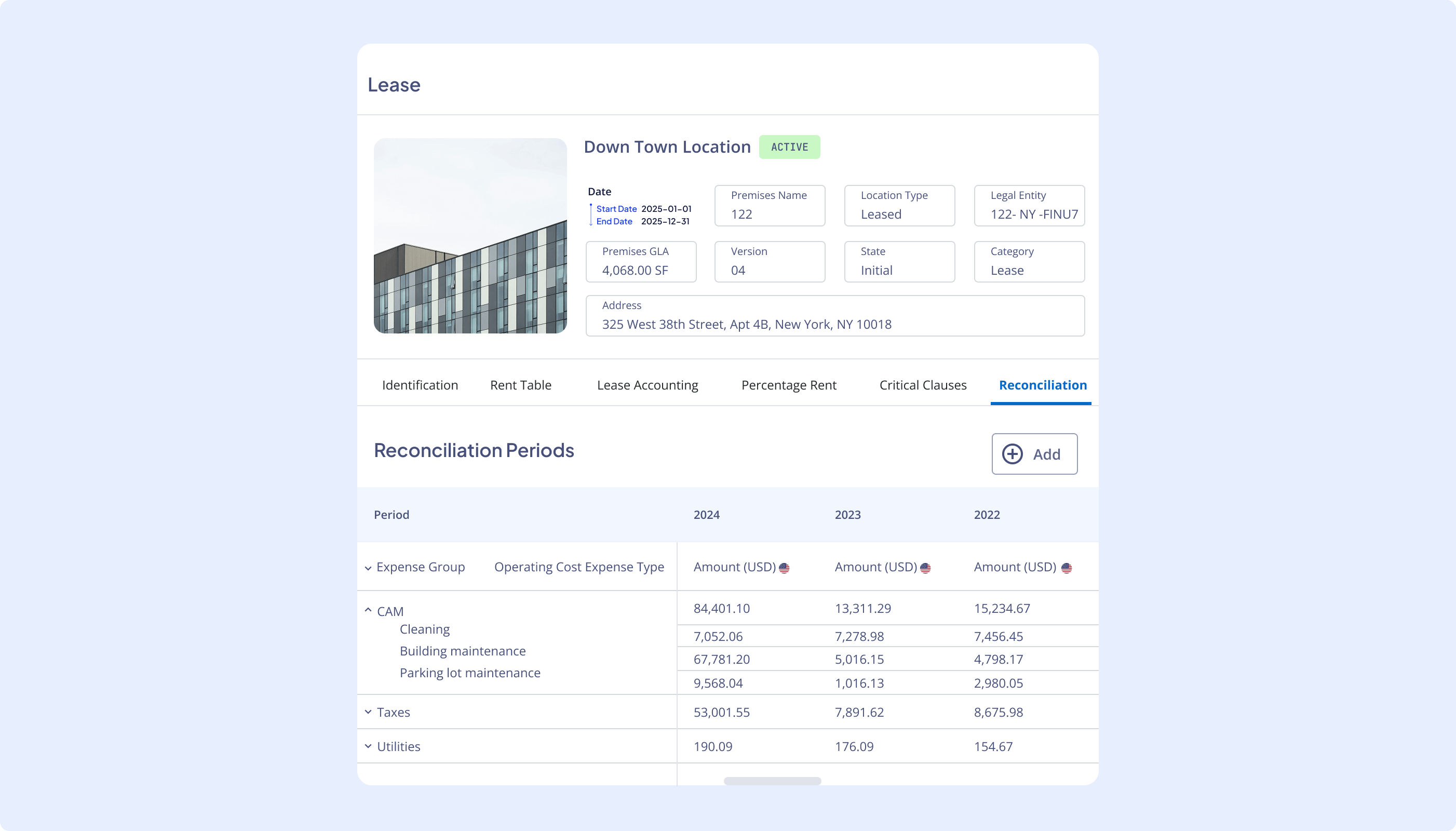
Easily reconcile non-lease expenses, including CAM, taxes, and utilities. Nakisa Portfolio Management helps identify discrepancies between billed amounts and contractual terms.
Beyond ensuring accurate operational management for CAM expenses, it is essential to maintain precise financial reporting for these charges. For compliance with IFRS 16 and ASC 842, Nakisa simplifies the classification of CAM costs into lease and non-lease components. It allows certain expenses, like maintenance, to be included in the base rent or treated as separate non-lease amounts. The platform also supports the allocation of a single expense across multiple categories, ensuring accurate differentiation between lease-related costs (e.g., security, HVAC) from non-lease components (e.g., marketing or administrative fees).
Additionally, Nakisa enables retailers to recalculate lease liabilities and ROU assets when CAM costs are included in lease agreements. Automated lease reassessments, proactive notifications, and detailed audit trails ensure accurate financial reporting, helping retailers track and adjust variable CAM costs throughout the lease term to stay ahead of fluctuations and prevent inaccuracies.
Managing property assessments and realty tax reconciliation
Owned and leased properties receive assessments on an annual or tri-annual basis to calculate property or realty taxes, along with municipal and school taxes from local governments. Property assessments, which determine the taxable value of a property, play a crucial role in tax reconciliation. Inaccurate or delayed reassessments can result in tax assessments falling below or exceeding current market values, leading to unexpected tax adjustments. Retailers may also face discrepancies between estimated tax payments and actual charges, requiring careful reconciliation to prevent overpayments, late fees, or disputes with landlords and tax authorities.
Property tax reconciliations are complex due to fluctuating tax assessments, changes in local tax rates, and jurisdiction-specific regulations. Global retailers must navigate multi-jurisdictional compliance challenges, ensuring accurate property tax reporting despite varying assessment methods and tax schedules.
Retailers may struggle to align estimated property tax payments with actual charges, creating discrepancies that must be addressed during reconciliation. Without a centralized system to track obligations and compare payments against assessments, they risk overpaying, incurring penalties for late payments, or engaging in disputes with landlords or taxing authorities.
Additionally, changes in lease terms—such as renewals, terminations, or modifications—can alter tax obligations, necessitating timely adjustments to avoid compliance risks and financial misstatements.
How Nakisa IWMS streamlines property tax calculation
Nakisa IWMS streamlines property and realty tax processes, ensuring compliance, transparency, and operational efficiency. The platform enables retailers to efficiently track and manage property assessments and taxes at the premises level, under the dedicated Assessment and taxes tab. A simple, intuitive interface allows contract managers to view existing assessments per each premise, add new assessments, upload relevant documents, and generate one-time charges for property and realty taxes, ensuring complete and up-to-date management of all tax-related data.
Comprehensive reporting capabilities offer detailed insights into store areas like selling spaces, warehouses, and offices, ensuring transparency and control over property tax obligations.
Nakisa supports the calculation and management of property tax across multiple jurisdictions, enabling compliance with local regulations seamlessly. By configuring tax settings for each region and linking relevant company codes to their respective jurisdictions, the platform ensures accurate reporting and efficient tax handling. It allows retailers to define specific property tax treatments, such as tax codes, rates, and exemptions, ensuring calculations are tailored to local requirements while minimizing manual intervention.
Tax adjustments further simplify property tax management by recalculating tax obligations whenever lease terms change, whether due to renewals, modifications, or terminations. This ensures accurate reporting and reduces compliance risks.
Automating sales tax calculations for leases
Beyond realty taxes, retailers must also account for sales tax implications on lease-related expenses. Sales tax calculations can be complex, as they vary depending on the jurisdiction, the nature of the leased property, and specific contractual agreements. Without proper visibility into sales tax obligations, retailers may miscalculate tax liabilities, leading to compliance risks or financial discrepancies. Ensuring accurate tracking and calculation of both realty and sales taxes is critical for maintaining financial integrity and avoiding unexpected tax adjustments.
How Nakisa IWMS streamlines sales tax management for global retailers
With Nakisa, real estate professionals can preview the sales tax that will be applied to the scheduled payments before they are posted. With sales tax calculation, they can define tax rates based on specific expense types and vendor agreements within a contract. In the Scheduled Payments view, sales taxes are broken down by expense category, displaying both the tax amount and the total payment due (tax-inclusive). This improved visibility into upcoming payments allows teams to forecast expenses more accurately and streamline budgeting for precise financial planning in future periods.
Ensuring accurate insurance clauses and reconciliation
Insurance clauses in lease agreements dictate coverage requirements, premium allocations, and liability responsibilities, making their management crucial for financial accuracy and compliance. Retailers operating across multiple locations must navigate varying insurance requirements, shared policy structures, and fluctuating premiums driven by claims history, coverage adjustments, or market rate changes. Without a clear process for managing these clauses, businesses risk budget shortfalls, disputes over cost-sharing with landlords, and unexpected financial exposures.
Lease agreements often specify how insurance costs should be allocated, particularly in multi-tenant properties where shared premiums must be distributed fairly. However, inconsistencies in lease terms, differing renewal cycles, and non-standard fiscal calendars complicate expense tracking and reconciliation. Retailers must ensure that insurance clauses are accurately enforced and that premium adjustments are properly reflected in lease obligations.
A centralized approach to managing insurance clauses helps retailers track policy terms, automate cost allocations, and proactively assess premium fluctuations. By maintaining clear documentation and fostering transparency with landlords and insurers, businesses can mitigate financial risks, streamline reconciliations, and ensure compliance with lease agreements.
Reconciling insurance premiums presents its own set of complexities, as costs often fluctuate due to claims history, coverage changes, or market-driven rate adjustments, making it hard to forecast and track accurately. For example, a retailer expanding operations or altering its risk profile may experience sudden increases in premiums that are not immediately reflected in estimated charges. Varying levels of coverage required across different locations further complicate the process, especially when reconciling shared premiums for multi-tenant properties. Insurance policies often cover multiple locations with varying risk profiles, requiring retailers to ensure costs align with lease agreements that specify how premiums are allocated across locations.
Discrepancies between estimated and actual premiums can result in budget shortfalls or disputes over shared costs with landlords. The challenge is heightened by differing policy renewal schedules and reconciling premiums across fiscal periods using non-standard accounting calendars. To avoid financial inaccuracies and ensure proper expense allocation, detailed documentation, clear communication with landlords or insurers, and accurate tracking and reconciliation are essential.
How Nakisa IWMS optimizes insurance clauses tracking and reconciliations
Nakisa IWMS streamlines the management of insurance clauses, ensuring compliance and accuracy in cost allocation. Within the dedicated Insurance tab at the contract level, real estate professionals can upload insurance documents, define policy terms, and apply preconfigured company-wide insurance types to standardize clause management.
The platform enables accurate tracking of insurance cost allocations across multiple locations, preventing disputes with landlords and reducing financial discrepancies. By automating premium reconciliation, Nakisa minimizes manual errors, enhances operational efficiency, and ensures that lease agreements reflect the correct insurance obligations—helping retailers maintain financial control and compliance.
Challenge 11: Ensuring accounting and compliance for IFRS 16, ASC 842, and local GAAP
Global retailers face significant challenges in lease accounting and compliance with IFRS 16, ASC 842, and local GAAP standards due to the complexity of managing numerous leases across multiple locations, jurisdictions, and lease types.
Automating lease recognition and classification
One of the primary challenges is the recognition of nearly all leases on the balance sheet as right-of-use (ROU) assets and lease liabilities, while also requiring classifying agreements as either operating or finance leases. Retailers must also scrutinize service contracts for embedded leases and account for them appropriately.
Additionally, leases often include non-lease components, such as maintenance services or utilities, which must be identified and separated from lease payments unless a practical expedient is applied. Accurately distinguishing these components requires a detailed analysis of contracts and collaboration across departments to ensure compliance with IFRS 16 and ASC 842.
This fundamental shift requires collecting detailed data on thousands of leases, which is a substantial task in itself.
Addressing IFRS 16 vs. ASC 842 accounting requirements
The divergences between IFRS 16 and ASC 842 add another layer of complexity for multinational retailers. These standards have different approaches to lease classification, measurement, and disclosure requirements, necessitating separate accounting treatments and reporting processes.
Handling lease modifications, renewals, and terminations
The complexity increases when dealing with lease modifications, renewals, and terminations, which impact financial statements and require detailed reporting. Retailers must accurately track these changes and understand their implications on the balance sheet. This is particularly challenging for retail locations with contracts that automatically modify under certain circumstances, such as co-tenancy clauses in mall leases.
Assessing right-of-use (ROU) asset impairment
Retailers must also monitor and assess ROU assets for impairment. Changes in market conditions, store performance, or other external factors could trigger impairments, requiring adjustments to financial statements. This is especially relevant for underperforming stores or locations affected by economic downturns.
Addressing discount rates and currency complexities
Determining the appropriate discount rate for lease liability measurement is a key compliance requirement under both IFRS 16 and ASC 842, directly affecting the calculation of Right-of-Use (ROU) assets and lease liabilities. The discount rate typically depends on the interest rate implicit in the lease or the lessee’s incremental borrowing rate when the implicit rate is unavailable. Variations in economic conditions, such as interest rates and inflation, across different jurisdictions can add complexity to this process for global retailers.
Furthermore, managing leases in multiple currencies presents challenges, particularly in terms of currency translation adjustments. Fluctuating exchange rates can impact the accuracy of lease liability and ROU asset calculations. As a result, retailers must ensure that lease data is centralized to support consistent and accurate financial reporting across different jurisdictions.
Managing CAM charges and operational costs
The reconciliation of CAM charges, property taxes, and insurance premiums further complicates matters, as these costs must be accurately allocated and reported according to lease agreements to avoid disputes or financial inaccuracies. Operating across multiple jurisdictions increases this complexity, as retailers must adhere to varying tax laws, reporting standards, and non-standard accounting calendars, which heightens the risk of non-compliance and audit findings.
Centralizing lease data and ensuring accuracy
Centralizing lease data is critical for ensuring accurate financial reporting and compliance with IFRS 16, ASC 842, and local GAAP standards. Retailers with multi-regional operations face significant challenges in consolidating lease information from various sources, including regional offices and disparate systems. These complexities are amplified by varying lease classifications (e.g., operating vs. finance leases) across regions, requiring careful attention to the treatment of each lease type for reporting purposes.
The absence of a unified data source exposes organizations to risks of discrepancies in lease liability measurements or ROU asset valuations, potentially impacting financial reporting at the consolidated level. Implementing centralized systems and automation tools ensures consistent data collection, reduces inefficiencies, simplifies compliance with both local and global standards, and improves reporting accuracy. This approach not only addresses the challenges of managing complex lease portfolios but also positions companies to adapt more readily to evolving accounting standards and regulatory requirements.
Meeting financial reporting and disclosure requirements
Global retailers must adhere to strict financial reporting and disclosure requirements under IFRS 16, ASC 842, and local GAAP standards. These standards mandate the disclosure of detailed information regarding lease liabilities, right-of-use (ROU) assets, lease terms, and payment schedules. These lease liabilities must be measured at the present value of future lease payments, with corresponding ROU assets reflecting the same value, adjusted for factors such as initial direct costs. Retailers must ensure that lease-related data is consistently presented in financial statements, which can be particularly challenging for those with a large portfolio of leases across different jurisdictions. To meet these demands, they must implement robust reporting systems and processes that facilitate timely and accurate disclosures.
Implementing compliance processes
Implementing and maintaining compliance with IFRS 16, ASC 842, and local GAAP standards requires significant administrative effort and collaboration between finance and lease management teams. This collaboration is especially important in multi-location environments with diverse accounting standards and local regulations. Retailers must implement new internal controls, invest in technology solutions to automate processes, reduce inefficiencies, and ensure accurate information for financial reporting.
Ensuring audit readiness
Retailers must also prepare for increased scrutiny during audits by maintaining detailed documentation and audit trails for all lease agreements. This includes demonstrating compliance with lease classification, modifications, impairment testing, and other requirements, which is crucial for passing internal and external audits.
Overall, the transition to IFRS 16, ASC 842, and local GAAP lease accounting standards presents a daunting task for large retailers, requiring careful planning, execution, and ongoing management to ensure compliance while minimizing operational disruptions.
How Nakisa IWMS helps retailers ensure lease accounting compliance
In Nakisa IWMS, Nakisa Lease Accounting provides a centralized platform with a powerful accounting engine that effectively addresses the lease accounting challenges of global retailers.
- Automated lease recognition and classification: Nakisa IWMS automates the recognition of right-of-use (ROU) assets and lease liabilities, enabling accurate classification of agreements as either operating or finance leases. This automation reduces the administrative burden associated with manually tracking lease modifications, renewals, and terminations—critical elements for accurate financial reporting. Additionally, Nakisa’s software accommodates both combined and separated treatment of lease and non-lease components, providing dedicated fields and calculations to fit the user’s preferences.
- True asset-level accounting: Nakisa’s true asset-level accounting capabilities allow for granular tracking of specific assets, such as individual store spaces, vehicles, or equipment, within a single contract. Each asset is tracked individually, with its own lifecycle, including unique amortization periods, start and end dates, and specific events like modifications, renewals, buyouts, and terminations. This granular approach ensures accurate management in compliance with accounting standards and provides detailed financial reporting.
- Parallel accounting compliance: The software ensures parallel compliance with IFRS 16, ASC 842, and local GAAP by supporting the recognition of ROU assets and lease liabilities, as well as efficient management of complex lease classifications and modifications. It enables simultaneous lease management across all standards on a single platform, generating disclosure reports that meet each standard’s requirements.
- Management of high-volume events: Nakisa efficiently handles lease modifications, renewals, and terminations, and impairments, ensuring compliance with IFRS 16 and ASC 842. The software automatically recalculates lease terms, adjusting right-of-use (ROU) assets and lease liabilities based on updated clauses, payment schedules, or lease terms in real-time. With a comprehensive audit trail, Nakisa provides full transparency, ensuring accurate financial reporting and reducing the risk of misstatements.
- Addressing discount rates and currency challenges: Nakisa’s solution automates the calculation of discount rates, crucial for accurate lease liability measurement under ASC 842 and IFRS 16. It calculates weighted average discount rates, tracks lease terms, and adjusts rates for lease modifications or reassessments. For multinational enterprises, Nakisa supports managing leases in multiple currencies, including local and reporting currencies. The platform automates currency conversion, FX adjustments, and indexation for complex currencies like Chile’s Unidad de Fomento (UF). It tracks real-time value fluctuations, ensuring accurate financial reconciliation and seamless ERP system integration for synchronized exchange rate management.
- Managing CAM charges and operational costs: With built-in tools for reconciling CAM charges, property taxes, and insurance premiums, Nakisa IWMS eliminates errors and disputes by ensuring accurate cost allocation and alignment with lease terms. The platform’s analytics capabilities support non-standard accounting calendars, multi-currency transactions, and multi-jurisdictional tax compliance, enabling seamless adherence to varying reporting standards. Additionally, automated workflows and detailed audit trails help mitigate the risk of non-compliance and audit findings, giving global retailers the confidence to manage complex global portfolios effectively.
- Lease data centralization: Nakisa’s integrated platform for capital projects, lease and facility management, and lease accounting, combined with its seamless integration with ERP (SAP, Oracle, Workday) and third-party financial systems (such as BlackLine), consolidates operational and financial lease-related data into a single asset repository. This integration eliminates dual data entries, enhances visibility across portfolios, and ensures all stakeholders have access to consistent, up-to-date information.
- Automated auditable financial reporting: Nakisa’s advanced reporting capabilities enable the generation of audit-ready reports with advanced drill-down capabilities, ensuring full compliance with IFRS 16, ASC 842, and local GAAP. The platform supports complex financial calculations, such as the measurement of right-of-use (ROU) assets and lease liabilities, while offering both standard and customizable reports. Retailers can automatically create comprehensive financial reports such as Income Statement, Balance Sheet, and Cash Flow, along with detailed disclosure reports, including Asset Roll Forward, Lease Liability, Weighted Average Lease Term, Weighted Average Discount Rate, and Maturity Analysis, which support regulatory filings like 10-K and 10-Q. The software also provides transactional and management reports, such as Consolidated Financial Schedules, Periodic Posting Status, Contract Expiration, and Data Quality and Integrity (DQI). Multi-dimensional reporting allows for scenario analysis and forecasting, evaluating the financial impact of different lease strategies.
- Implementing compliance processes: The platform also fosters enhanced collaboration between finance and lease management teams by providing an integrated system where accountants and contract managers work together on a single asset repository. Role-based workflows and team-specific user interfaces enable each team to work independently while maintaining alignment, reducing redundancies, and improving overall efficiency. With automated processes for lease classification, calculations, and reporting, Nakisa IWMS reduces administrative overhead and ensures efficiency across global portfolios.
- Ensuring audit readiness: Nakisa IWMS enhances audit readiness with built-in tools for maintaining detailed documentation and audit trails for all lease agreements. It automates key processes such as lease classification, modifications, and impairment testing, ensuring compliance with regulatory requirements. The platform provides comprehensive reporting and real-time visibility into lease data, enabling retailers to quickly respond to audit inquiries and demonstrate compliance. With centralized record-keeping and configurable controls, Nakisa IWMS minimizes risks and ensures a smooth audit process.
Overall, Nakisa IWMS empowers global retailers to streamline lease accounting and compliance processes, mitigate operational risks, and achieve strategic financial management. Its advanced capabilities make it an indispensable tool for retailers managing complex lease structures across multiple geographies and asset types.
Shawn Husband
Senior Director, Lease Center of Expertise at Walmart
Challenge 12: Managing third-party vendors and multi-vendor invoicing
Global retailers face significant challenges in managing relationships with landlords across their expansive property portfolios and third-party companies—such as maintenance providers, equipment repair specialists, cleaning services, and security teams. Effective external collaboration is crucial for ensuring high service levels and controlling costs.
Manually tracking and reconciling these payments across multiple locations and partners increases the risk of errors, delayed payments, and potential disputes with landlords or service providers. This lack of visibility can also make it difficult to maintain compliance with lease agreements and regulatory standards.
Without a centralized platform, managing multiple contracts, service level agreements (SLAs), performance metrics, and ensuring accurate invoicing is overwhelming. From a financial perspective, retailers must maintain accurate records, manage cash flow, and ensure timely payments to avoid late fees, strained vendor relationships, and missed cost-saving opportunities. Shared costs, such as Common Area Maintenance (CAM) charges, property taxes, and insurance premiums, must align precisely with lease terms. Inconsistent data tracking or errors in reconciling these costs can result in disputes, financial discrepancies, and compliance risks.
From an operational standpoint, the lack of visibility into vendor performance and service delivery inconsistencies can lead to inefficiencies, delays, and costly breaches of contract. Communication breakdowns can exacerbate these issues, creating misunderstandings and delaying the resolution of property-related concerns.
Vendor risk management is another critical factor. Retailers must assess vendor reliability, financial stability, and adherence to contractual obligations to prevent disruptions. This requires regular performance reviews, up-to-date certifications, and compliance with evolving regulatory requirements.
As retailers grow and expand into new locations, the challenges of managing third-party relationships multiply. Monitoring external contractors’ performance across multiple locations, ensuring compliance with insurance and regulatory requirements, and tracking the ever-increasing number of agreements and contracts require robust systems and processes to prevent inefficiencies. To address these challenges, retailers need centralized platforms that provide real-time visibility into vendor and landlord performance, facilitate collaboration, automate contract tracking, and support compliance with both service agreements and lease terms.
How Nakisa simplifies third-party management and invoicing for global retailers
Nakisa IWMS offers a comprehensive suite of features designed to help retailers optimize third-party management, including landlords, tenants (for subleases), vendors, contractors, consultants, and more. Central to this functionality is the Partner Portal, a hub that provides retailers with a detailed, easy-to-filter directory of all third parties, complete with contact details, a history of past interactions, and even third-party performance scoring (especially valuable for contractors). For each third-party company, the system tracks regular payments, one-time operating costs, and all relevant documents, including service level agreements (SLAs).
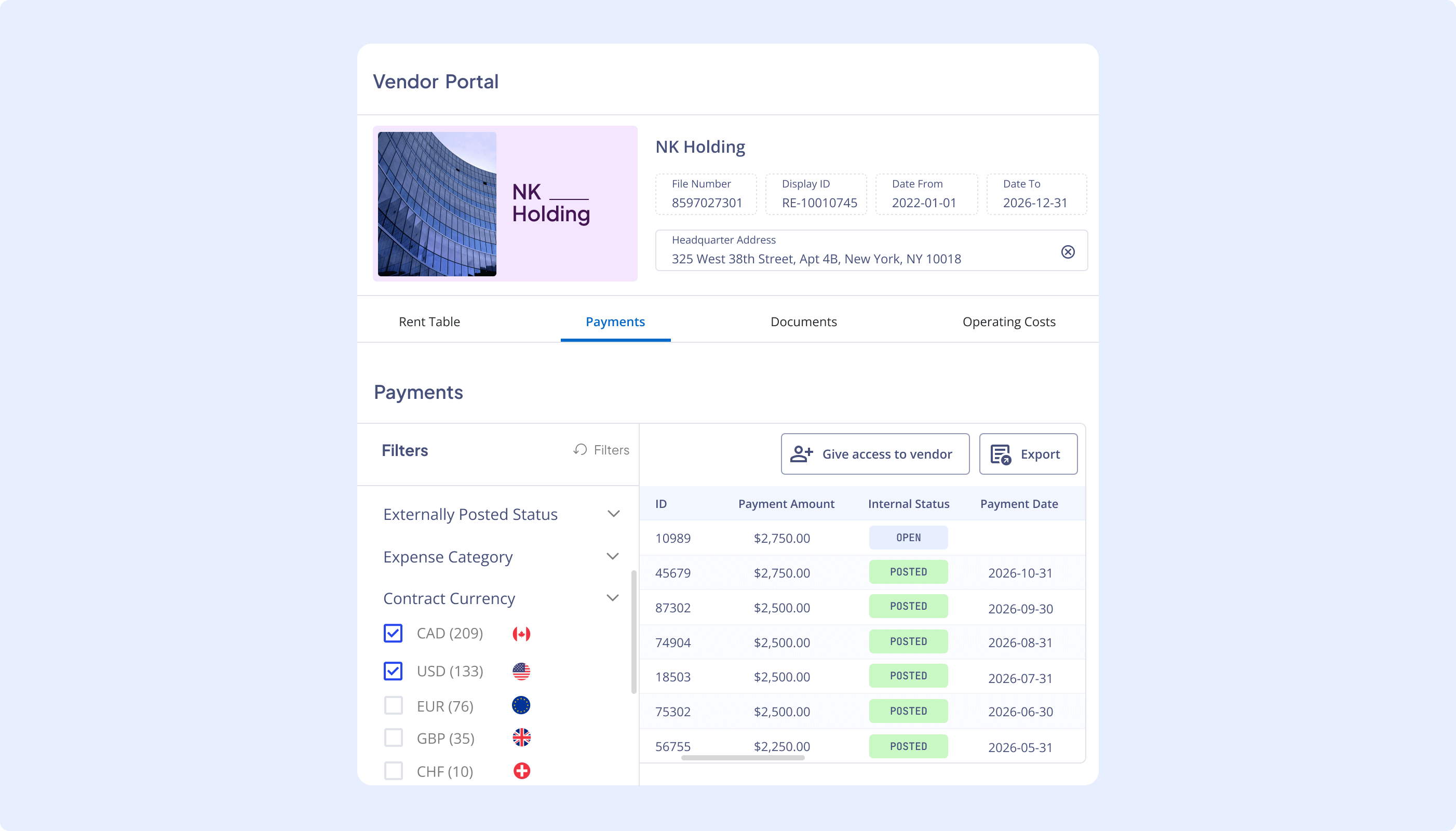
Have your vendors upload invoices and credit notes directly to the vendor portal and communicate with you through the same platform under Nakisa IWMS
The invoice management tool within Partner Portal allows third parties to securely upload invoices, which the system then automatically checks and reconciles against lease terms. This ensures that all transactions align with contractual obligations, enhancing accuracy and reducing manual intervention, while still maintaining effective cost control. This functionality is specifically valuable during reconciliation activities, including CAM, property taxes, and insurance. Key processes such as percentage-based rent calculations and CAM reconciliation are fully automated, reducing manual errors, improving financial efficiency in reconciliations with landlords, and facilitating accounting audits.
With detailed tracking capabilities, retailers can easily match payments to corresponding invoices and lease conditions, minimizing the risk of errors or disputes. Seamless integration with internal General Ledger (GL) and ERP GL systems ensures that financial data flows smoothly between Nakisa and the retailer’s broader financial infrastructure, further promoting operational efficiency and accuracy.
Nakisa supports complex scenarios, including multi-vendor invoices, multi-currency, and multi-calendar use cases (including 4-4-5 and 4-5-4 calendars), allowing retailers to manage diverse financial transactions seamlessly.
The platform also supports bulk payments and provides a comprehensive audit trail, enabling efficient management of multiple vendors while preventing late payment penalties.
By addressing these key areas, Nakisa IWMS empowers retailers to streamline their vendor and landlord management, reduce operational complexities, and improve efficiency in managing their extensive property portfolios.
Rodolfo Etelwof Juarez Arevalo
IFRS and Accounting Policies Manager at Unicomer Group
Challenge 13: Improving facility management for retail operations
Maintaining retail facilities in optimal condition is critical to avoiding operational disruptions that can impact revenue and customer satisfaction. Unplanned equipment breakdowns, delayed repairs, or unresolved maintenance issues can lead to costly downtime, especially during peak retail seasons. For global retailers, the complexity of facility management is amplified by the diversity of property types they oversee—stores, warehouses, and distribution centers—all with unique maintenance requirements. Coordinating maintenance requests, tracking work orders, and managing preventive schedules across multiple sites becomes increasingly complex.
Unifying asset and facility data across retail locations
Retailers operate across diverse locations, each with its own set of facilities, assets, and operational requirements. One of their biggest challenges is maintaining an accurate, up-to-date inventory of assets and facility-related data, which is often scattered across multiple disconnected systems and applications.
Without a centralized system for assets and facilities, retailers face inconsistencies in data, increasing the risk of errors, duplicated efforts, and overlooked maintenance needs. This results in costly delays, prolonged downtime, and missed opportunities for preventive maintenance, all of which negatively impact business operations and profitability.
Additionally, reconciling financial data related to asset maintenance and depreciation across different locations becomes a cumbersome process, increasing the likelihood of budgeting inaccuracies and financial discrepancies.
How Nakisa IWMS centralizes asset and facility data
Nakisa IWMS, through its Facility Management Suite, addresses key challenges faced by global retailers in facility management. It provides a single source of truth for all facilities, their associated assets, and inventory parts, as well as the historical data of maintenance, repairs, and inspections for any item, whether an asset or a facility.
Nakisa’s centralized, comprehensive asset register allows facility managers to efficiently manage the full lifecycle of physical assets, from acquisition to maintenance. The asset register tracks and stores key data points—including vendor or lessor information, model, location, condition, work order history, downtime, and performance statistics. It also links related documentation such as lease or purchase agreements, repair manuals, warranties, and attached work orders, creating a complete historical record.

Leverage a centralized data hub for all your assets and facilities. Attach documents, work orders, and track asset performance in Nakisa Facility Management.
Under the asset register, facility managers can leverage the inventory feature, enabling up-to-date tracking of parts usage and replenishment planning. This minimizes delays and ensures continuous operations, reducing downtime and optimizing resource utilization.
Optimizing maintenance, inspections, and work order management
Balancing preventive and reactive maintenance is a significant challenge for global retailers. Managing diverse property types requires prioritizing tasks based on urgency and impact. For instance, a malfunctioning HVAC system in a store demands immediate attention to maintain customer comfort, while a minor repair in a warehouse may be deferred.
Retailers must efficiently assign tasks to internal teams or external service providers, monitor work status in real time, and track technician performance to ensure timely resolution and service quality. Without a structured work order system, they struggle to efficiently track, prioritize, and resolve maintenance issues across multiple locations.
Work orders provide a standardized process for logging maintenance requests, assigning tasks to the appropriate teams or external vendors, and monitoring progress in real-time. A robust system ensures that urgent repairs are addressed promptly, while routine maintenance and inspections are scheduled systematically to prevent costly equipment failures. By integrating work orders with asset records and inventory tracking, retailers can optimize resource allocation, streamline vendor coordination, and maintain a complete history of service activities for compliance and auditing purposes.
Additionally, keeping up with routine facility and asset inspections is crucial for ensuring safety, compliance, and operational efficiency. Missed inspections can lead to regulatory violations, unexpected breakdowns, and increased risks of liability.
How Nakisa IWMS automates maintenance, inspections, and work order management
Nakisa Facility Management streamlines both scheduled and reactive maintenance with a robust work order system and advanced inspections.
- Scheduled maintenance: Facility managers can schedule regular preventive maintenance by setting recurring work orders. They can specify the start and end date and define the frequency in days or months. Once a work order for the designed period is completed, it triggers the appearance of the next one, ensuring continuous upkeep and minimizing equipment failures.
- Reactive maintenance or repairs: For unplanned repairs, facility managers can create work orders to track costs, downtime, and task progress. The system allows for priority levels (from critical to low) to be assigned, determining urgency and lead times. It also tracks both estimated and final repair costs for better budget management. After repairs, an inspection ensures quality, and managers can attach parts, documentation, and comments for streamlined collaboration.
- Work orders: Used for scheduled and reactive maintenance, work orders are essential for tracking and prioritizing tasks, monitoring work status, comparing expected vs. actual time and costs, and generating reports on outcomes and technician performance. Nakisa enables grouping and hierarchy of multiple work orders to manage large maintenance and repair needs. In-app and email notifications ensure stakeholders stay informed and aligned.

Efficiently manage work orders for scheduled maintenance and repairs in Nakisa Facility Management.
- Inspections: Nakisa offers purpose-built functionality to manage and track inspections, helping retailers ensure compliance and proactively address maintenance needs. It provides configurable inspection templates to tailor inspections for each region or business unit if needed. Within the Inspection List, facility managers can add items from the asset register, noting their condition, priority, and any relevant details. They can also flag the need for work orders for scheduled maintenance or urgent repairs. This proactive approach helps resolve small issues before they escalate into larger, more costly problems.
Fostering communication and collaboration for facility maintenance
Clear communication and collaboration between teams and departments are essential for effective work order management across multiple locations. Retailers struggle with fragmented communication channels, leading to missed updates, misunderstandings, and delayed responses. Maintenance teams, facility managers, and external service providers often rely on different systems or manual methods to communicate, which can slow down resolution times. Streamlined communication and collaboration are necessary to ensure that all parties involved are aligned, work orders are tracked, and issues are resolved promptly.
How Nakisa improves communication and collaboration for facility maintenance
Nakisa helps eliminate fragmented communication by providing a centralized platform for all teams and departments involved in facility maintenance. For internal collaborators, the solution serves as a centralized source of truth and enables seamless communication between maintenance teams and facility managers, allowing them to collaborate in real-time. With assigned tasks, comments, in-app notifications, email reminders, and the action center, they all stay on track.
For external providers, Nakisa offers the Partner Portal and invoice management, as discussed above. The Partner Portal serves as a centralized third-party directory, including a history of collaboration, contractor performance tracking, and a comprehensive view of all recurring and one-time payments. This hub enhances transparency and simplifies the management of external relationships. By allowing external providers to upload invoices directly, Nakisa fosters more effective collaboration, streamlines processes, and ensures smooth communication, leading to faster resolution of any issues.
By integrating with existing systems and centralizing all communication, Nakisa keeps all stakeholders informed and aligned, reducing the risk of missed updates or delays, speeding up response times, and ensuring quick resolution of issues.
Integrating real estate and financial systems
The integration of maintenance and work order management systems with other enterprise systems (e.g., ERP, financial, real estate management, and procurement systems) remains a significant challenge for many retailers. Disjointed systems lead to data silos and inaccuracies in. Integrating these systems ensures alignment of work orders, asset management, and financial data, providing a comprehensive view of operations across locations.
Without an effective facility management system, retailers risk relying on reactive, inefficient processes that result in higher repair costs, longer resolution times, and missed sales opportunities. A centralized, technology-driven approach to maintenance and work order management is essential to minimizing disruptions, ensuring timely repairs, and keeping operations running smoothly across all locations. This not only improves operational efficiency but also plays a crucial role in maintaining customer satisfaction and brand reputation in the competitive retail landscape.
How Nakisa IWMS ensures seamless integration with retail systems
Nakisa IWMS offers a fully integrated approach, starting with real estate and asset portfolio platforms and extending to broader enterprise solutions, including ERP systems.
- Integration with the Nakisa ecosystem: Nakisa Facility Management, as part of Nakisa IWMS, seamlessly integrates with both the Portfolio Management and Lease Accounting suites. This integration allows real-time sharing of premises and assets between various teams, ensuring consistent data and streamlined processes. For example, leased assets can be automatically added or updated from Nakisa Lease Accounting to Nakisa Facility Management. This integration prevents data duplication, maintains system consistency, and ensures the smooth alignment of work orders, asset management, and financial data, improving operational efficiency across teams.
- APIs IoT integration and third-party SaaS: Nakisa extends its capabilities by integrating IoT technology, which provides real-time updates on asset performance, service needs, and potential downtime. This data enables more accurate monitoring and the implementation of predictive maintenance strategies, which help prevent costly repairs and downtime. Additionally, Nakisa supports APIs that enable easy integration with third-party applications, allowing businesses to further enhance their IWMS with specialized tools and technologies.
- Integration with financial systems and ERPs: Nakisa offers native bidirectional integrations with major ERP systems like SAP, Oracle, and Workday. This ensures a seamless flow of financial data, work orders, and asset management information between Nakisa and your organization’s financial systems. By syncing this data, Nakisa ensures that financial records align with operational activities, streamlining processes and reducing the risk of errors or discrepancies.
This integrated approach ensures Nakisa IWMS provides a unified system that connects asset management, facility operations, and financial systems, enhancing collaboration, increasing efficiency, and promoting data accuracy across all departments.
These were the key challenges global retailers face while operating and managing their leases and facilities. Another important challenge is energy management, which lies at the intersection of operating and optimizing leases and facilities. You can learn more about it in the next section.

Optimizing and long-term support
As retailers move beyond the stages of operating and monitoring leases, the focus shifts to maintaining, optimizing, and ensuring the long-term efficiency of their real estate and facilities. This stage is crucial for driving sustained operational excellence and supporting broader business goals, such as customer satisfaction and sustainability. Key challenges often include facility management, energy management, implementing a data hub for analytics and reporting, as well as space management and the integration of smart building technologies and IoT.
Challenge 14: Leveraging data-driven decisions for retail growth
Global retailers struggle with making data-driven decisions due to the complexity of managing large, multi-location portfolios with diverse leases and contracts. Each asset comes with unique financial and operational metrics, complicating the consolidation of data for actionable insights on a global scale. Let’s explore data-related challenges below and how Nakisa assists with them.
Addressing data consistency, data quality, and integration challenges
Maintaining data quality and consistency across a global portfolio is a crucial challenge for organizations operating in multiple regions. In many cases, businesses face inconsistent data entry practices, where different teams or regions follow their own methods for entering and updating data. This lack of standardization can result in discrepancies, such as duplicated records or missing information, which negatively impact the accuracy of analytics.
In addition, many organizations continue to rely on legacy, siloed systems that were not designed to communicate with one another. These disconnected systems make it difficult to consolidate data from different departments or regions, leading to fragmented views of business operations. The manual processes often involved in updating and reconciling these systems only exacerbate the situation, introducing human error and inefficiency.
The complexity of maintaining data quality and consistency is further heightened by the varying data standards and reporting requirements across different countries and regions. Each country may have its own legal, regulatory, and compliance standards, leading to differing formats for data, as well as distinct reporting practices. For instance, financial data may need to adhere to different tax rules or accounting standards depending on the jurisdiction. This lack of harmonization makes it increasingly difficult to achieve a unified view of global operations, hindering decision-making and overall business performance.
Ultimately, the challenge lies in managing these multiple data streams, standardizing practices, and ensuring consistency across the organization to enable reliable analytics that drive informed decision-making and strategic planning.
How Nakisa IWMS centralizes and standardizes retail data
Nakisa IWMS centralizes operational and financial data in a single repository, bridging the gap between capital projects, real estate, finance, facility management, and executive teams. With native bidirectional integrations with major ERP systems (SAP, Oracle, and Workday), powerful APIs, and native bidirectional cross-product integrations, Nakisa IWMS eliminates data silos and ensures data consistency across systems. This addresses the challenge of maintaining data quality and accuracy and provides retailers with a holistic view of the portfolio, enabling faster and more informed decisions about assets.
By providing a centralized, data-driven approach, Nakisa IWMS empowers retailers to allocate resources effectively, optimize portfolio performance, and strategically plan for the future. The platform's comprehensive support for the full asset management lifecycle enables global retailers to make informed decisions across all aspects of their portfolio.
Managing historical data migration and system transition
Migrating data across different applications and systems presents a complex set of challenges, particularly when it comes to maintaining data integrity and consistency. Legacy systems often house data in various formats, with inconsistent structures and standards, which can lead to errors or omissions during the migration process. The risk of losing critical information, altering data unintentionally, or compromising its quality is high if the migration is not managed carefully.
It is equally important to preserve the context of the data during migration. Historical records, contracts, and financial information often have significant context tied to them, such as amendments, terms, and compliance requirements, which must be retained for the data to remain useful and accurate. Without proper management, data migration can result in a loss of this important context, which may hinder decision-making and reporting in the new system. Additionally, the migration process must also ensure that the data remains compliant with global regulations, which can vary from region to region.
Given these complexities, it is essential that organizations invest in robust migration strategies that not only ensure the seamless transfer of data but also safeguard its accuracy, security, and accessibility. Maintaining data integrity across multiple systems ensures that the migrated data remains reliable and supports better decision-making and operational efficiency in the new platform. Without careful planning, data migration risks could undermine the value of the new system and impact organizational performance.
How Nakisa IWMS streamlines data migration and change management
With over 20 years of experience working with Fortune 1000 companies, Nakisa ensures smooth transitions and long-term success through expert enablement and change management, offering tools, training, and ongoing dedicated support. Nakisa IWMS provides robust tools to help clients seamlessly migrate historical data to its cloud-native solutions.
Shawn Husband
Senior Director Lease Center of Expertise at Walmart
The process begins with Nakisa’s comprehensive data import functionality, which ensures historical data is efficiently brought into the system while maintaining compliance with global standards. To support the migration process, Nakisa offers a flexible file storage feature, allowing clients to upload disclosure reports and other key documents for periods before the cutover date. These reports are securely stored with timestamps and user details, ensuring safe, easy access for future reference.
Additionally, Nakisa’s migration flag feature allows clients to easily identify and manage migrated leases. This functionality simplifies batch operations, import/export tasks, and reporting on migrated data, thus enhancing accuracy and reducing errors.
Jose Alejandro Campos Portillo
ERP Functional Lead at Unicomer Group
Nakisa’s platform also supports flexible file uploads, allowing contract administrators to upload documents in various formats (e.g., PDFs, Word, and Excel) without requiring conversion or compression. Each document is linked with essential metadata for better tracking and accountability.
For larger datasets, Nakisa provides robust API tools for bulk uploads, enabling the seamless import of files of any size, while also preserving metadata for efficient data management. Furthermore, Nakisa’s migration tool supports the transfer of objects created in other systems, ensuring continuity in the migration process.
Together, these tools ensure a smooth, efficient, and secure transition for clients migrating their historical data to Nakisa's platform, maintaining data integrity, ensuring regulatory compliance, and offering a seamless user experience.
Last but not least, Nakisa’s experts from various industries work closely with clients, offering tools, training, and ongoing dedicated support to navigate every stage of the migration process. These industry experts bring deep knowledge of global data standards, compliance regulations, and best practices, ensuring that each client benefits from a seamless transition experience.
Real Estate Lease Administrator, Information Management
Enhancing real-time analytics and market responsiveness
Tracking real-time analytics is critical for portfolio optimization but requires advanced tools to integrate data from various sources, such as point-of-sales systems, inventory management, facility management, and lease management and accounting systems. Traditional reporting methods lack the flexibility for ad-hoc analysis, leaving retailers unable to adapt quickly to market shifts or pinpoint underperforming assets.
Without centralized dashboards and configurable filters that handle multi-currency and multi-language data, it’s difficult to effectively track key metrics and optimize decisions at the portfolio, contract, lease, or asset level. This lack of visibility leads to inefficiencies, missed opportunities, and suboptimal decisions, ultimately hindering retailers’ profitability and long-term growth.
Adding to the challenge, industry-specific complexities further complicate decision-making for global retailers. These challenges include aligning location performance with evolving consumer trends, adjusting lease terms to account for fluctuating market conditions in various countries, and evaluating the financial impact of contract renewals or terminations.
How Nakisa IWMS empowers retailers with real-time insights
Nakisa IWMS addresses these challenges head-on by offering a comprehensive and integrated approach to data management and analysis, specifically designed to meet the needs of global retailers. The platform provides seamless integration, powerful analytics, and reporting capabilities, all while maintaining robust security measures and compliance with industry standards.
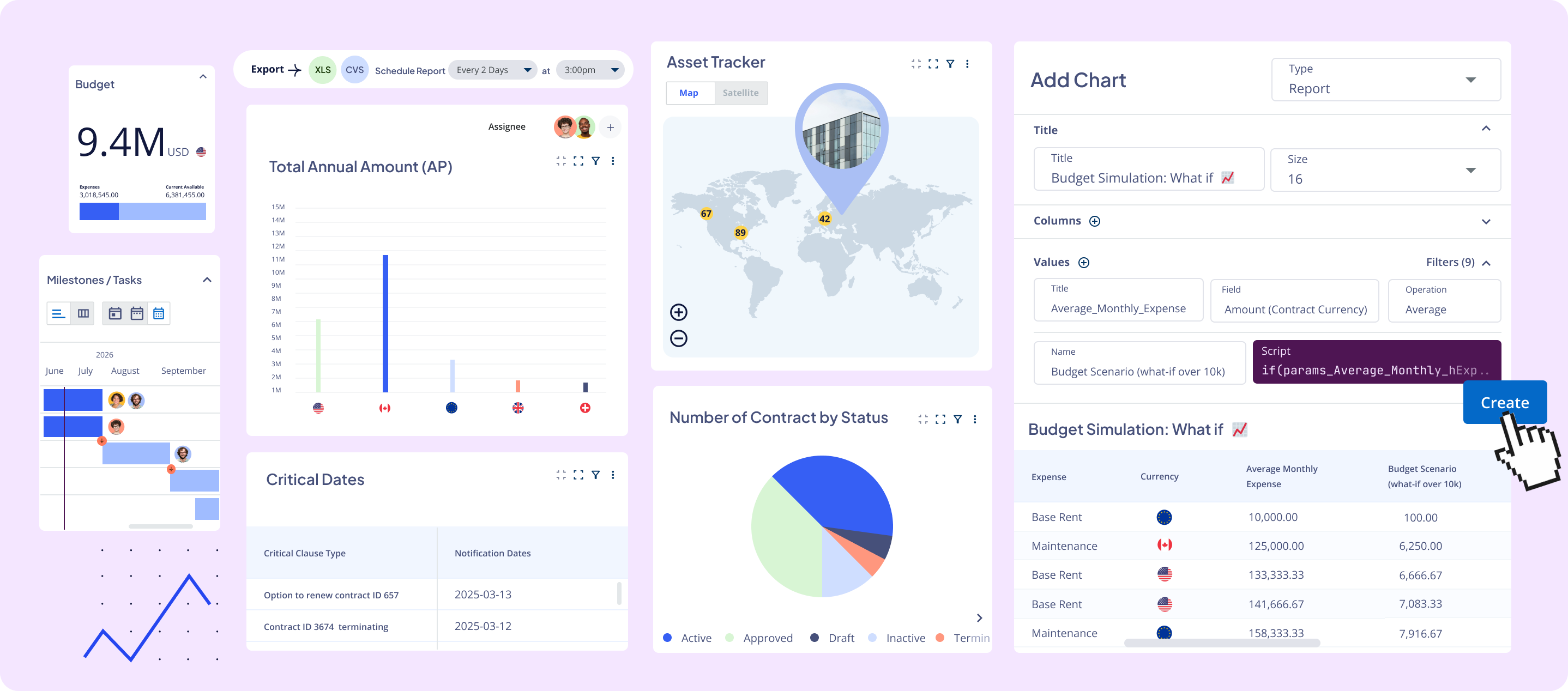
One of the core strengths of Nakisa IWMS is its out-of-the-box reports and dashboards. With built-in, out-of-the-box reports, dashboards and no-code formulas, Nakisa IWMS democratizes access to real-time insights, enabling users of all skill levels to track key performance indicators, forecast needs, and simplify audit preparation. The system’s real-time data visualization provides up-to-date information crucial for timely decision-making. To further support the decision-making process, Nakisa IWMS also includes industry-specific, pre-built reports for percentage rent calculations or CAM reconciliation with multi-currency support. These features are particularly beneficial for retailers operating across multiple jurisdictions and dealing with diverse lease structures, providing them with the tools necessary to navigate the complexities of global retail operations.
In addition to these features, Nakisa IWMS offers highly configurable reports and dashboards, tailored to organizations with complex requirements. With advanced filtering options and robust scripting capabilities, the platform can be easily customized to suit specific business scenarios. This level of configurability is essential for retailers who need to align the platform with their unique operational needs and decision-making processes.
Moreover, Nakisa AI Agent for dashboard creation significantly empowers real estate professionals. They can now ask the chatbot to create a specific graph by using plain English or other supported languages. Nakisa AI Agent suggests the most appropriate graph format based on the query. Once approved, it automatically generates the graph. This feature makes it easier for users to get exactly the insights they need, when they need them, without requiring technical expertise.
Another powerful functionality is the Nakisa AI Assistant. It provides accurate answers and instant analytics across the entire portfolio. Users can ask questions about Nakisa’s functionality or their data and receive accurate results faster. This makes it incredibly easy for users to access the information they need, while also enhancing their understanding of how to navigate and utilize the platform effectively.
Ensuring security and compliance in retail IT systems
Data-driven decision-making must account for compliance with various regulations, such as data privacy laws (e.g., GDPR), as well as risk management considerations. Balancing these factors with business objectives adds another layer of complexity to the decision-making process on an international level.
Transitioning to a data-driven culture often requires significant change management efforts, as employees may resist moving away from intuition-based decision-making. This challenge is amplified by the need to align diverse teams across multiple time zones and languages.
Global retailers must also consider the varying quality and cost of data across different regions, as well as the challenges of integrating data from multiple sources in different countries. Overcoming these barriers requires a comprehensive strategy that addresses technological, organizational, and cultural aspects of data-driven decision-making on a global scale.
How Nakisa IWMS ensures enterprise-grade data security and compliance
Nakisa is built on a robust, secure platform. To safeguard sensitive data, Nakisa uses encrypted tunnels for secure data transmission between Nakisa platform, ERP, and other systems. Once data is stored, encryption at rest protects it on trusted platforms like Amazon AWS and Microsoft Azure. Further security measures, such as role-based access control, access control lists, Single-Sign-On (SSO), and virtual private cloud firewalls, minimize external threats. Regular audits ensure compliance with ISO, SOC 1, and SOC 2 standards, restricting access to authorized personnel and maintaining the highest levels of data security. Nakisa also adheres to GDPR requirements and IT General Control (ITGC) standards, further solidifying its commitment to compliance and data protection.
Rodolfo Etelwof Juarez Arevalo
IFRS and Accounting Policies Manager at Unicomer Group
Challenge 15: Meeting energy efficiency and sustainability goals
With rising energy costs and increasing pressure from regulators and customers to reduce environmental impact, meeting sustainability goals has become a key priority for retailers. Failure to comply can result in financial penalties, legal disputes, and reputational damage.
Effective energy management requires tracking usage, identifying inefficiencies, and implementing sustainable practices across facilities. This is especially challenging for retailers with large, multi-location portfolios, where energy consumption patterns vary greatly between sites. Additionally, staying compliant with evolving regulations around energy use and sustainability can be complex. Retailers must balance cost savings with environmental responsibility, all while meeting customer expectations for sustainability.
How Nakisa IWMS helps global retailers optimize energy usage
Nakisa provides retailers with tools to track and manage energy usage across premises, helping them optimize consumption and align with sustainability goals and regulatory compliance. The platform converts waste, water, gas, and electricity consumption into CO2 emissions, providing a clear picture of the environmental impact across facilities.
By centralizing and visualizing energy data, Nakisa IWMS enables facility managers to identify inefficiencies, set measurable sustainability targets, and implement energy-saving initiatives. This holistic approach empowers retailers to reduce their carbon footprint, improve resource efficiency, and contribute to broader environmental and corporate social responsibility goals, all while achieving cost savings through optimized energy usage.
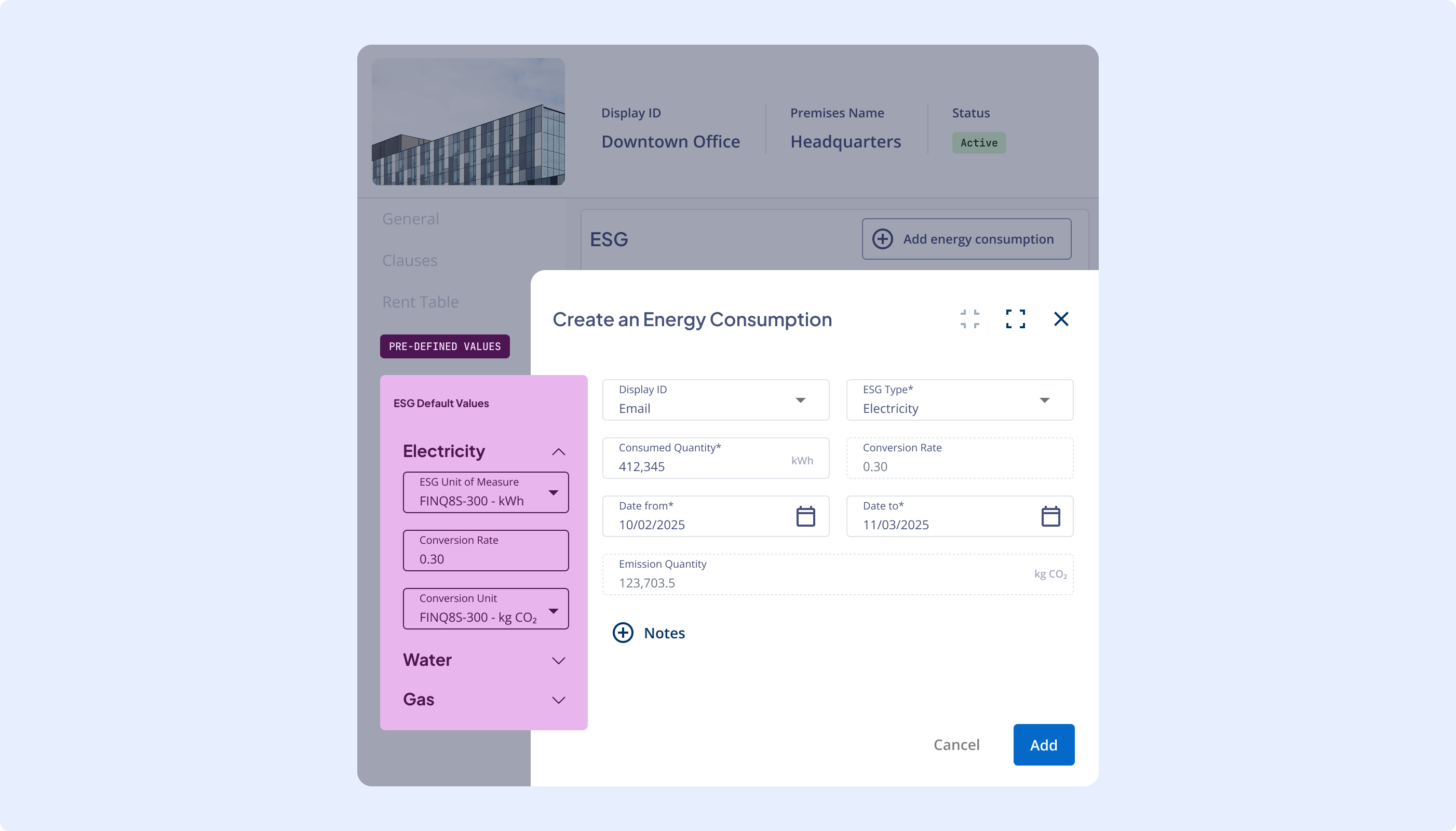
Monitor and optimize your energy consumption with Nakisa IWMS.
Conclusion: transforming asset and facility management for global retailers with Nakisa IWMS
As this guide has illustrated, global retailers face significant challenges in planning, managing, and optimizing their diverse, multi-location, capital-intensive portfolios. Balancing operational efficiency with broader organizational goals, while remaining responsive and competitive in ever-changing market conditions can overwhelm even the most experienced teams.
Cloud-native, AI-powered IWMS solutions like Nakisa IWMS are designed to address these complex needs. By centralizing and streamlining critical business functions—from capital planning and budgeting to site selection, contract management, payment processing, reconciliations, lease accounting, disclosures, facility management, repair and maintenance, and sustainability initiatives— Nakisa provides rapid visibility, optimizes costs across global operations, and enables accurate forecasting of needs and trends. These capabilities empower retailers to plan proactively for growth and adapt swiftly to market changes.
As the retail sector continues to evolve, leveraging an innovative IWMS solution is essential for retailers aiming to optimize their operations and drive sustainable growth. However, not all IWMS solutions are created equal.
Discover how Nakisa IWMS stands out from the market. We invite you to experience a personalized demo of our software and see why market leaders such as Walmart, PUMA, Nestlé, Louis Vuitton, L'Oréal, Rona, FairPrice, and Unicomer trust Nakisa to manage their portfolios effectively.


